Archive for the ‘Wildlife’ Category
Thursday, December 1st, 2011
Corporate Tin Miner:
“We will continue to be aggressive explorers with multiple rigs focused on exploration for the foreseeable future.”
.
~ Venture Minerals (corporate tin miner from Perth), in its Mt Lindsay-Investor Presentation,
(Nov 2011), p.31
.
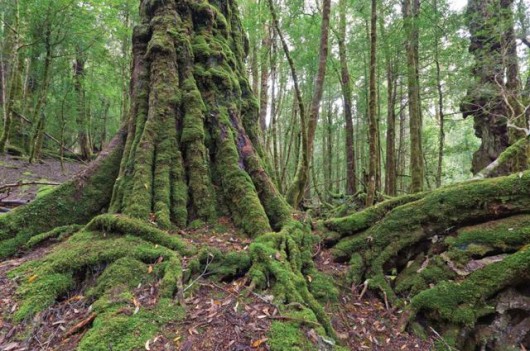 ‘The Tarkine’ – 430,000 hectares of ancient Tasmanian forest ‘The Tarkine’ – 430,000 hectares of ancient Tasmanian forest
Tasmania’s ancient Myrtle/Sassafras forest – threatened by loggers, logger ‘adventure tourism’, roads and now bloody tin mining!
[Photo by Peter Walton, Tasmanian Expeditions – Photo Gallery on The Tarkine, ^http://www.tasmanianexpeditions.com.au/index.php?section=photo_highlights&id=285742]
.
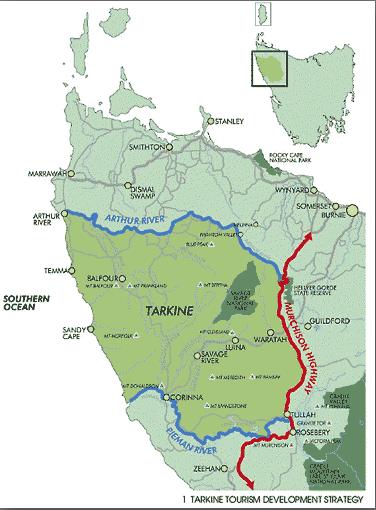 Cradle Coast Authority (CCA), North West Tasmania’s map
as part of a tourism development strategy. Cradle Coast Authority (CCA), North West Tasmania’s map
as part of a tourism development strategy.
.
A bid to restore emergency National Heritage protection to the Tarkine wilderness in Tasmania’s north-west has been launched by environmentalists to head off a ”Pilbara-style” mine in the rainforest. Several conservation groups lodged the nomination with the Environment Minister, Tony Burke, hoping he will count heritage values in his impending decision on the big Venture Minerals’ Mount Lindsay open cut project.
Emergency listings of The Tarkine have been granted four times since 2004!
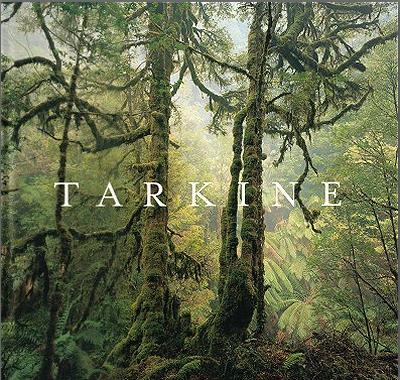 Moss-clad Sassafras (Atherosperma moschatum) trees in the Arthur River catchment near Waratah, Tarkine, Tasmania
(Photo © Ted Mead November 2003)
[Front Cover of the 2004 book, ‘Tarkine‘ edited by Ralph Ashton, and available from publishers Allen and Unwin,and just purchased by The Habitat Advocate.
Available at: ^http://www.allenandunwin.com/default.aspx?page=94&book=9781742372846]
Moss-clad Sassafras (Atherosperma moschatum) trees in the Arthur River catchment near Waratah, Tarkine, Tasmania
(Photo © Ted Mead November 2003)
[Front Cover of the 2004 book, ‘Tarkine‘ edited by Ralph Ashton, and available from publishers Allen and Unwin,and just purchased by The Habitat Advocate.
Available at: ^http://www.allenandunwin.com/default.aspx?page=94&book=9781742372846]
.
…but that’s not how the ‘Tin Men‘ see The Tarkine…
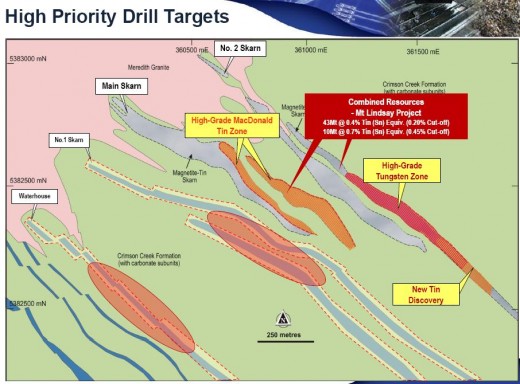 This is how the ‘Tin Men‘ see the Tarkine… for its tin and tungsten.
(Source: Venture Minerals’ Mt Lindsay-Investor Presentation, Nov 2011) This is how the ‘Tin Men‘ see the Tarkine… for its tin and tungsten.
(Source: Venture Minerals’ Mt Lindsay-Investor Presentation, Nov 2011)
.
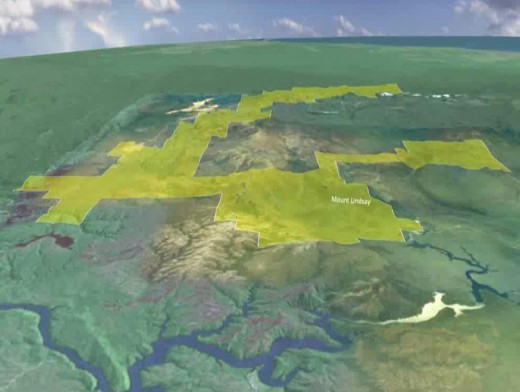 …and this is how the ‘Tin Men’ see the Tarkine… for the vast mining lease area they are happy to exploit and lay to waste. …and this is how the ‘Tin Men’ see the Tarkine… for the vast mining lease area they are happy to exploit and lay to waste.
(Source: Venture Minerals’ Mt Lindsay-Investor Presentation, Nov 2011)
.
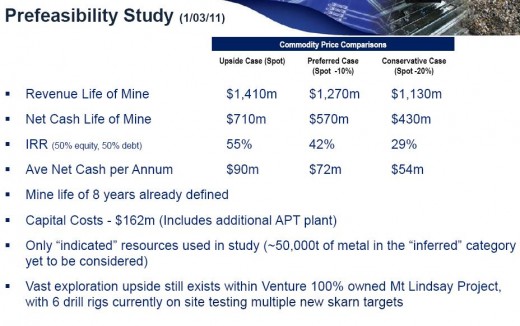 …and this is how the Tin Men see the Tarkine – for its ‘Super Mining Profits’ … 30 to 55% return! …and this is how the Tin Men see the Tarkine – for its ‘Super Mining Profits’ … 30 to 55% return!
(Source: Venture Minerals’ Mt Lindsay-Investor Presentation, Nov 2011)
.
The Mount Lindsay tin project is the largest of several mines planned around the Tarkine in an emerging new Tasmanian environmental battle. The Tarkine National Coalition said up to nine new open cut mines are in development there. Mr Burke allowed a previous emergency listing for the Tarkine to lapse a year ago when he said plans for a road through the wilderness were dropped. Environment groups objected because of what they said were increasing threats from mining.
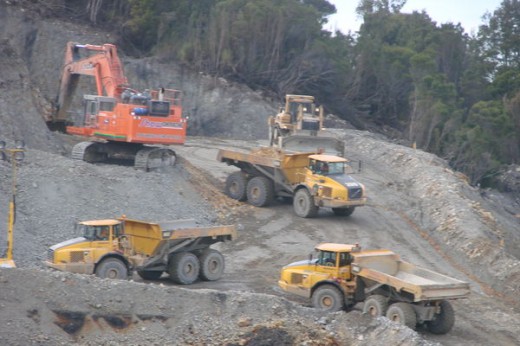 Corporate Miner ‘Metals X’ getting well stuck into a Tarkine rainforest hillside at nearby Mount Bischoff Corporate Miner ‘Metals X’ getting well stuck into a Tarkine rainforest hillside at nearby Mount Bischoff
.
The 430,000-hectare Tarkine region is undergoing a protracted assessment for future listing by the Australian Heritage Council. But because the wilderness now lacks any listing, Mr Burke is unable to consider heritage values in an approval of the Mount Lindsay mine under the Environment Protection and Biodiversity Conservation Act. Instead, his decision is likely to focus on protection of endangered species such as the Tasmanian Devil. The Tarkine is the wildest remaining stronghold for healthy devils, stricken across the rest of the island by a deadly facial cancer.
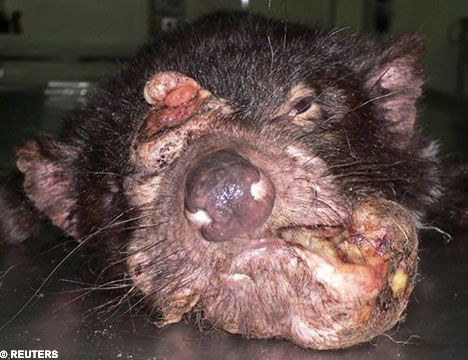 The Tarkine is a refuge for healthy Tasmanian Devils to avoid the genocidal tumour disease
..but what could heartless commercial ‘Tin Men’ care?
Think of the ‘Super Mining Profits’ … 30 to 55% return! The Tarkine is a refuge for healthy Tasmanian Devils to avoid the genocidal tumour disease
..but what could heartless commercial ‘Tin Men’ care?
Think of the ‘Super Mining Profits’ … 30 to 55% return!
.
The Tarkine National Coalition spokesman Scott Jordan said yesterday:
”Companies, including Venture, are using the removal of the heritage protections to ramp up exploration activities including roading and drilling that are having a significant effect on the values of the area.”
.
The coalition was joined by the World Wildlife Fund, the Australian Conservation Foundation and The Wilderness Society in seeking the listing. An Australian National University environmental law specialist, Andrew Macintosh, said emergency listings had been granted four times since 2004, but Mr Burke was not compelled to respond to the request. In a statement, Mr Burke did not respond directly to the emergency listing request, but said he would continue meeting with different groups on issues surrounding the heritage listing of the Tarkine. [Editor’s note: in fact there has been one emergency National Heritage listing (Dec 2009 – Dec 2010), one National Heritage nomination (2004), three emergency National Heritage nominations (Nov 2009, Mar 2011 and Nov 2011), and two AHC recommendations (2003 and Sep 2010)… so what’s it bloody take to get the message through?]
.
[Source: ‘ Call for heritage listing of the Tarkine to head off tin mine‘, Sydney Morning Herald, 20111119, ^ http://www.smh.com.au/national/call-for-heritage-listing-of-the-tarkine-to-
head-off-tin-mine-20111118-1nndq.html]
.
.
‘Jobs, jobs, jobs’ justification – but all for mainlanders, foreigners and short-termers
.
Typically, this miner (Venture Minerals) relies on the standard jobs justification to exploit, dig up, pollute and destroy the Tarkine Wilderness for tin. Venture Mineral is promising 700 jobs! But of those , 500 jobs involve construction – so short term fly ins from the mainland and overseas only during construction phase. The remaining 200 jobs are promised for the mine’s operations. But miners don’t train locals. This is not about Tasmanian jobs. These 200 jobs will be sourced from similar mines on the mainland and indeed from overseas all on on Federal Labor’s 457 Visa (Australian worker displacement) Scheme. Just look at OZ Minerals at Rosebery.
457 Visas: ‘..for employers who would like to employ overseas workers to fill nominated skilled positions in Australia, to employ overseas workers for a period of between one day and four years.’
[Source: ^http://www.immi.gov.au/skilled/skilled-workers/sbs/]
.
Venture Minerals is Perth-based at 181 Roberts Road Subiaco, another West Australian corporate miner exploiting Tasmania and taking the profits offshore. Venture Minerals forecasts $1 billion in revenue but it won’t go to Tasmanians. It will go back to West Australia and to its rich mine shareholders. Typically mining is eco-rape, pillage and plunder – wam, bam, thank you mam, then pissing off back to where one came, leaving another tin moonscape like Mount Bischoff.
Look at the mining legacies across Tasmania left as moonscapes:
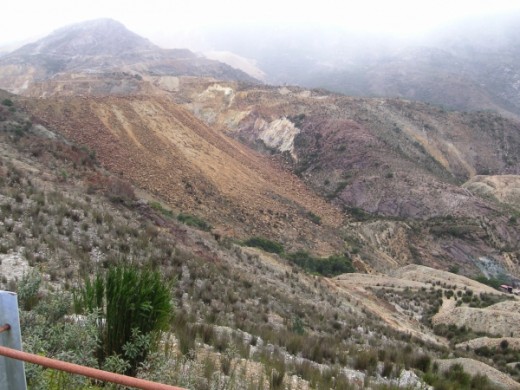 Nearby Mount Bischoff Tin Mine – wam, bam, thank you mam! Nearby Mount Bischoff Tin Mine – wam, bam, thank you mam!
.
- Kara Mine in Hampshire
- Mount Lyle’s sulphuric moonscape
- Henty Mine
- Briseis Mine at Derby
- Pioneer Mine on Bradshaws Creek
- Anchor Mine on Blue Tier
- Gladstone Mine
- Coles Bay Mine
- Ben Lomond Mine
- St Paul’s River Mine
- Flinders Island Mines
- Mount Heemskirk
- Mount Balfour
- Renison Bell
- Stanley River
- Mount Cleveland
- Cox Bight
- Melaleuca
- etc
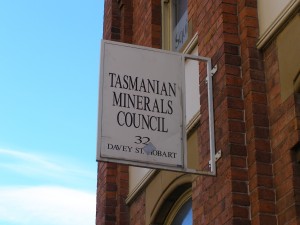
And of course the Tasmanian Minerals Council backs mining in The Tarkine. And of course it opposes national heritage listing of the Tarkine. The Tasmanian Minerals Council is only about the financial bottom line, exploitation of ore and perpetuating its own existence.
 The Tasmanian Minerals Council claims that there are “already enough layers of protection across the Tarkine region, where about 80% of the land has been put in multiple use reserves that allow mining“. The Tasmanian Minerals Council claims that there are “already enough layers of protection across the Tarkine region, where about 80% of the land has been put in multiple use reserves that allow mining“.
What ‘layers of protection’? If 80% of the Tarkine is reserved form mining, how can that be for protection? – for protection of mining profits and royalties perhaps.
So Tony Burke, if you’re not to pre-occupied with resolving the future of the Murray-Darling, what time are you allocating for Tasmania’s ancient Myrtle forests?
.
.
.
‘Tasmania’s Tarkine wilderness is one of the world’s largest temperate rainforests.
This vast expanse is a wilderness wonderland of wild rivers, dramatic coastal heathlands, button grass plains, bare mountains, ancient Huon pines, giant eucalypts and myrtles and extraordinary horizontal scrub.
It is home to rare and endangered birds – like the Orange-bellied parrot and the White goshawk – and countless animals such as the Eastern pygmy possum. This superbly illustrated book captures the beauty of this unique wilderness.’
.
[Source: ^http://www.andrewisles.com/all-stock/publication/tarkine]
.
Orange-bellied Parrot
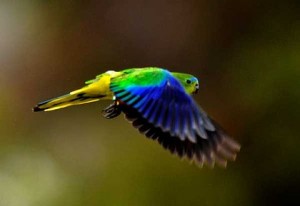 ‘Here at Melaleuca, six days’ walk from the nearest road,
such moments of peace are typically broken by bird calls,
including the distinct buzzing of the orange-bellied parrot’.
.
[Source: ‘Scientists Race To Rebuild Parrot Population’, by Peter Ker, Sydney Morning Herald, 20110207, ^http://www.globalanimal.org/2011/02/07/scientists-race-to-rebuild-parrot-population/29032/] ‘Here at Melaleuca, six days’ walk from the nearest road,
such moments of peace are typically broken by bird calls,
including the distinct buzzing of the orange-bellied parrot’.
.
[Source: ‘Scientists Race To Rebuild Parrot Population’, by Peter Ker, Sydney Morning Herald, 20110207, ^http://www.globalanimal.org/2011/02/07/scientists-race-to-rebuild-parrot-population/29032/]
.
Current status:
‘The Orange-bellied parrot (Neophema chrysogaster) is one of 18 birds listed as endangered under the Tasmanian Threatened Species Protection Act 1995. It is also listed as endangered under the Federal Act and has the dubious honour of being one of the most endangered birds Australia wide.
Why is it endangered? The Orange-bellied parrot is endangered because it is so rare (only 200 birds left) and its habitat is quickly disappearing.
.
There are only about 50 breeding pairs of this bird left!
..but what could heartless commercial ‘Tin Men’ care?
Think of the ‘Super Mining Profits’ … 30 to 55% return!
.
‘…It is a breeding endemic of Tasmania, which means that it only breeds in Tasmania. In fact it only breeds in one place in Tasmania and that is in our Southwest National Park. It arrives here in summer, nesting in eucalypt tree hollows adjacent to the parrot’s feeding grounds of extensive coastal buttongrass plains.’
.
[Source: http://www.dpiw.tas.gov.au/inter.nsf/webpages/bhan-54g3c5?open]
.
Tags: 457 visas, Cradle Coast Authority, Environment Minister, high priority drill targets, Melaleuca, Metals X, Mount Lindsay, Orange-bellied Parrot, Pieman River, super mining profits, Tarkine Tourism Development Strategy, Tarkine Trails, Tarkine wilderness, Tasmania, Tasmanian Devil, Tasmanian Minerals Council, The Tarkine, tin man, tin men, tin mine, Tony Burke, tungsten mine, Venture Minerals, wam bam thank you mam
Posted in Birds (Australian), Tasmania (AU), Tasmanian Devils, Threats from Mining, Threats to Wild Tasmania | 8 Comments »
Add this post to Del.icio.us - Digg
Friday, November 18th, 2011
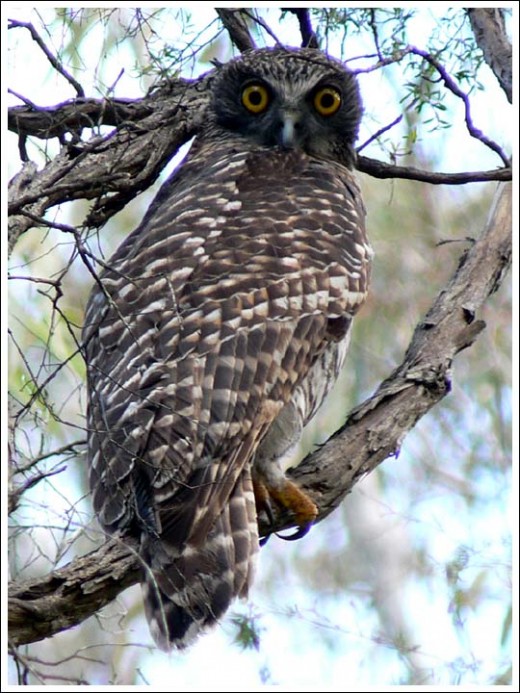 Powerful Owl (Ninox strenua)
(© Photo by Duncan Fraser, ^http://bencruachan.org/blog/?p=170) Powerful Owl (Ninox strenua)
(© Photo by Duncan Fraser, ^http://bencruachan.org/blog/?p=170)
.
The Powerful Owl (Ninox strenua) is Australia’s largest owl, yet in Victoria it has become a threatened species due to human destruction of old growth forest habitat; particularly the destruction of hollow-bearing trees used by this owl for nesting, roosting and home for its natural prey – possums. ‘Powerful Owls are adversely affected by the clearfelling of forests and the consequent conversion of those forests into open landscapes, but the species may persist in forests that have been lightly or selectively logged.’
[Source: ^http://www.birdsaustralia.com.au/our-projects/powerful-owl-wbc.html]
.
Since European settlement, 65% of Victoria’s forest cover has been cleared (Woodgate & Black 1988). Only 5% of freehold land remains forested. This past permanent loss of habitat has likely led to an overall reduction in owl numbers and fragmentation of the original continuous population into a series of small residual populations, each of which is at risk of becoming locally extinct.

‘It is estimated that hollows suitable for owls do not form, even in the fastest-growing eucalypts, until they are at least 150-200 years of age (Parnaby 1995). Of 21 nest trees observed by McNabb (1996) in southern Victoria, about 50% were senescent and all ranged between 350-500 years of age, based on data collected by Ambrose (1982).
Over much of its range, the lack of suitably large hollows is considered to be a limiting factor to successful breeding and population recruitment. The Powerful Owl is, therefore, vulnerable to land management practices that reduce the availability of these tree hollows now or in the future. The loss of hollow-bearing trees has been listed as a potentially threatening process under the Flora and Fauna Guarantee Act (SAC 1991).
In addition, prey density may be an important determinant in territory size and breeding success, particularly considering that only the male hunts during the breeding season. Seebeck (1976) estimated that about 250 possums (or their equivalent) would be required per year by a family group and recent studies have estimated around 300 prey items for a breeding pair rearing two young (Webster unpubl. data.). Key prey are also dependent on hollow trees.’

In its final recommendation the Scientific Advisory Committee (SAC 1994) has determined that:
‘the Powerful Owl is significantly prone to future threats which are likely to result in extinction, and very rare in terms of abundance or distribution.’
.
The short-term conservation objective is to prevent further decline by ensuring that good quality habitat for at least a population target of 500 breeding pairs of Powerful Owl is maintained on public land in Victoria.
[Source: ‘Powerful Owl Action Statement‘, Victorian Government’ s Department of Natural Resources and Environment (or whatever its latest incarnation is), ^http://www.oren.org.au/issues/endspp/powerfulowlAS.htm]
.
.
‘Impact of Bushfire on Sooty Owls and Powerful Owls’
[Source: Rohan Bilney, Report on Sooty Owls and Powerful Owls for the Supreme Court proceeding number 8547 of 2009 – Environment East Gippsland v VicForests, pp.12-13]

Greater Sooty Owl (Tyto tenebricosa)
.
‘Fire is likely to kill individual owls and small mammals, and remove potential habitat in the short-term, potentially resulting in long-term impacts.
‘How owl populations adapt or respond to fire is largely unknown’
.
‘Fire can consume hollow-bearing trees, while also stimulating hollow formation, but as hollow formation can take decades, frequent fires are likely to result in a net loss of hollow-bearing trees from the landscape (Gibbons and Lindenmayer 2002). This is likely to cause detrimental effects to all hollow-dependant fauna (Catling 1991; Gibbons and Lindenmayer 2002; Garnett et al. 2003).
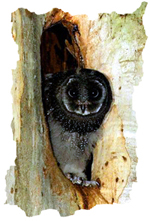
‘Sooty Owls typically occupy habitats subject to infrequent fire regimes such as wetter forest types, possibly due to higher densities of hollow-bearing trees in such landscapes. Frequent fire regimes also simplify habitat structure, which can cause deleterious impacts on terrestrial mammals (Catling 1991; SAC 2001), which includes increased predation rates by feral predators due to the loss of habitat refuge (Wilson and Friend 1999). Overall, it therefore seems likely that owls and small mammals will be negatively impacted by frequent fire regimes. It is likely, however, that it will be the impacts of fire on prey densities that dictate how the owls respond to fire.
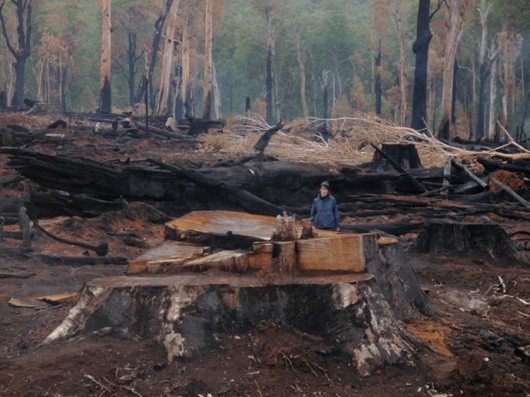 Brown Mountain ancient old growth logged, incinerated, razed by VicForests
(Photo by Environment East Gippsland) Brown Mountain ancient old growth logged, incinerated, razed by VicForests
(Photo by Environment East Gippsland)
.
‘Most species are not adapted to fire per se, but adapted to a particular fire regime, which include fire aspects such as intensity, frequency, seasonality and scale (Bradstock et al. 2002). Due to variations in the life history requirements of species and their ability to survive fire, particular fire regimes can advantage some species, while being deleterious to others (Bradstock et al. 2002; Gill and Catling 2002; Keith et al. 2002). Due to the varying ecological responses to fire, it is important for biodiversity conservation that we not only understand species responses to particular fire regimes, but to ensure that appropriate fire regimes are maintained across the landscape. As prescribed fire is used as a management tool for reducing fuel load to minimise fire risk, it is important that its effects on biodiversity are well understood.
‘Unfortunately, knowledge on how native species respond to particular fire regimes is poorly understood, especially for fauna (SAC 2001, 2003; Clarke 2008). So, in the absence of this crucial ecological information it is virtually impossible to implement appropriate fire regimes which will result in minimal negative ecological impacts, let alone enhance biodiversity. Fire, both prescribed burning and wildfire, can present a threat to owls if conducted at inappropriate seasons, frequency, intensity or scales. It is therefore difficult to quantify the threat. The threat of inappropriate burning at high fire frequencies is likely to be mainly concentrated around human assets and populations, while fires in more remote forested areas will be subject to less frequent fires (DSE 2004). Fire also affects the entire owl population because all habitats occupied by owls is flammable.
‘Victoria has experienced three catastrophic fire events in the past 7 years, and combined with prescribed burning, approximately three million hectares have been burnt in this time.‘
‘This equates to approximately 2/3 of potential Sooty Owl habitat in Victoria. How populations of Sooty Owls and many other forest dependant fauna have been affected by these fires remains poorly understood or unknown. The ability for forest fauna to recover is therefore being hampered by further prescribed burning, and recovery is also hampered by reduced fecundity caused by a decade of drought, and for the owls, low prey population densities.’
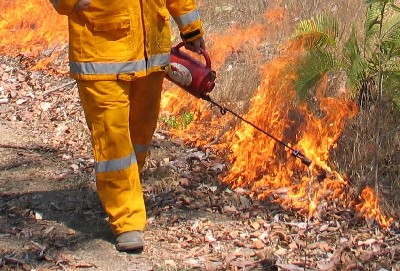
.
.
The ‘Bushfire Fighting Principle’ corrupted by blinkered economic rationalism
.
The traditional principle of bushfire management is to put out bushfires…one would think. Yet this simple concept has been hijacked, bastardised and corrupted by successive governments as a consequence of systemic under-resourcing. Government under-resourcing has contributed to the deadly human toll in recent years.
The corrupting of this core bushfire management principle has morphed into a blanket one-size-fits-all defeatist policy of broadscale prescribed burning – burning the bush before it burns. The bushfire management tradition of ‘suppression‘ has been economically rationalised and politically supplanted by the proactively sounding notion of ‘prevention‘.
In Victoria, the fundamental job of putting out bushfires has bureaucratically morphed into a ‘Code of Practice for Fire Management on Public Land’, with its two general principles…
.Fire management planning on public land must address the threat of wildfire, guide the use of prescribed burning, and provide for the achievement of integrated land management objectives such as human safety and environmental management.’ (Clause 50)
‘Fire management activities must be undertaken in a participative manner where the responsibility for reducing the likelihood and consequence of wildfire is appropriately shared between public and private land holders and managers.’ (Clause 51)
.
What happened to the fundamental principle of bush fire fighting?
To put out bushfires!
Instead, vast areas of remaining native bushland and forests across Australia are being deliberately burnt to the point where critical faunal habitat is sterilised – only the trees remain, while the rich underlying vegetation, demonised as ‘hazardous fuel‘ is incinerated and repeatedly prevented from regrowth. Wildlife habitat has become a fuel hazard targeted for burning by the very custodians charged with wildlife conservation. And out of the Victorian Royal Commission into the Black Saturday bushfires, the anticipated kneejerk response by bushfire agencies to commence Prescribed Burning Armageddon against the bush has started as many genuine conservationists have feared.
And what has been the full realised cost of the 2009 Victorian Bushfires – valuing human lives, human injuries, ongoing trauma, livelihoods, wildlives, livestock, private property, natural assets, on top of the direct operational response cost, the indirect costs of contribiting agencies, the donations raised, capital costs, the opportunity costs, the investigation costs, the Royal Commission costs? No one has come up with a figure. These values were outside the Victorian Royal Commission’s terms of reference – so what real value was it? Economic rationalising of emergency management is costing lives and contributing to species extinctions.
.
.
Victorian Government Policy of Bushfire Lighting
.
The Victorian Government’s delegated custodian on natural areas across the State is the infamous Department of Sustainability and Environment (DSE), with a reputation for lighting most of the bushfires it euphemistically labels as ‘prescribed burning’ wherein it finds unburnt bushland and prescribes its own burning regimes. When such custodial agencies restore the word ‘conservation‘ back into their title, some respect may return.
DSE’s ‘Code of Practice for Fire Management on Public Land‘ was revised in 2006. It relies upon background premises that since “much of the Australian continent is fire-prone”, that “fire occurs naturally”, that “many species of vegetation and wildlife have adapted to living within the natural fire regime” and that “Victoria’s Indigenous people used fire as a land management tool for thousands of years”. The Code justifies that “Victoria’s flora, fauna and the ecosystems they form are adapted to fire of varying frequencies, intensities and seasonality.” Victoria’s Flora and Fauna Guarantee Act 1988 has objectives to ensure “Victoria’s native flora and fauna can survive, flourish, and retain their potential for evolutionary development”. Now the integrity of this Act is under threat. Perversely DSE’s Code of Practice argues that deliberate burning of bushland and forest habitat will help Victoria’s native flora and fauna to survive, flourish, and retain their potential for evolutionary development.
Crap!
DSE stretches its rationalising propaganda further, claiming that excluding bushfire can have “negative consequences for Victoria’s flora and fauna“. And this is where the hijacking, bastardisation and corrupting turns from mythology into unsubstantiated falsehood and misinformation. No document exists to zoologically prove that native fauna will suffer such negative consequences if it does not have a bushfire range through its habitat. As a result, the Code of Practice implies that bushfire is ok for all Victorian bushland and forests – DSE conveniently convinces itself that the urgent moral imperative for DSE to suppress bushfires is extinguished. So now it lights more fires than it puts out.
The Code also premises that “often these wildfires can be difficult to suppress”. Well no wonder with an grossly under-resourced, firetruck-centric volunteer force.
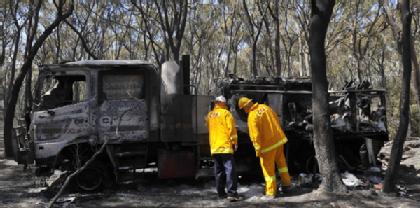 . .
.
‘DSE holds fire management workshop in Bendigo’
.
On 22nd June 2011, DSE staged a workshop of stakeholders to discuss some recommendations of the Royal Commission into Victoria’s February 20o9 bushfire tragedy. According to the website ‘Friends of Box-Ironbark Forests’, in attendance were representatives from the CFA, local government, The Wilderness Society, Bendigo Field Naturalists Club, Friends of Kalimna Park, North Central Victoria Combined Environment Groups [NCVCEG], Apiarists Association and DSE attended a workshop on June 10 to learn about the process for implementing the findings of the Victorian Bushfires Royal Commission. Though Friends of Box-Ironbark Forests (FOBIF) was not invited to this workshop, we were represented by members of some of the other groups.
Once again DSE’s Code of Practice for Fire Management on Public Land (COP) is to again be reviewed and updated, except its premises have not changed, so what’s the point? The following notes taken on the issue of Fire management Zones/Prescriptions is telling of how disconnected DSE is from wildlife habitat conservation:
.
‘Fire Management Zones (FMZ) have been reviewed recently. An interim zoning is to be released soon. With little time left the group briefly discussed the merits of fire management zones, and how they might relate to the risk model. It was highlighted that the residual fuel load is an important aspect, but further detail as to how was not provided.
NCVCEG made the point that the current diagram used by DSE to represent the relationship between ecological outcomes and fire management outcomes across the four FMZ is misleading, encourages poor planning, discourages biodiversity management in zones 1 and 2, and neglects to recognise that fire management outcomes may be achieved in all zones, especially where integrated planning and alternative practices (to prescribed burning) are established.
In relation to FMZ the Apiarists pointed out that Box Ironbark forests generally have very low fuel levels in comparison to heavily forested regions where many lives were lost during the fires in 2009. The merit of burning areas used for honey production was questioned and the long term impacts of severe burning on Box Ironbark forest ecology was raised.’
.
[Source: Friends of Box-Ironbark Forests, 20110622, ^http://www.fobif.org.au/2011/06/dse-holds-fire-management-workshop-in-bendigo/]
.
.
Yet at the same time DSE points out that… ‘biodiversity is in decline‘
.
In its ‘Victoria’s Biodiversity Strategy 2010–2015: Consultation Draft‘ DSE reminds us that two hundred years of (immigrant deforestation), severe droughts, major bushfires and the impact of climate change, has severely affected Victoria’s species and ecosystems. DSE professes:
- Victoria is the most cleared and densely populated state in Australia. Victoria has the highest proportion (48%) of sub-bioregions in Australia in poor condition, with four out of Australia’s five most cleared bioregions found in western Victoria (CES 2008).
- Approximately half of Victoria’s native vegetation has been cleared for agricultural and urban development, including 80% of the original cover on private land. Victoria is losing native vegetation at a rate of some 4,000 hectares per year, mostly from endangered grasslands (DSE 2008).
- Victorian landscapes are the most stressed in the country (NLWRA 2001). One third of Victoria’s major streams are in poor or very poor condition. Two thirds of wetlands have been either lost or degraded and nearly half of our major estuaries are significantly modified. Flows at the Murray mouth are estimated to be a quarter of what would naturally occur (VCMC 2007).
- 44% of our native plants and more than 30% of our animals are either extinct or threatened (CSIRO 2004). The highest number of threatened species in any one region in Australia occurs in north western Victoria.
- Exotic species represent about 30% of the Victorian flora with 1,282 species considered naturalised and a further 214 species considered incipiently naturalised in Victoria. This has increased from 878 naturalised species in 1984. It is estimated that an average of 7.3 new plant species establish in Victoria per year, and this number is increasing by a rate of 0.25 plants per year. Approximately 90% of the native vegetation in Melbourne is impacted by weeds, with more than 50% considered severely degraded. There are 584 serious or potentially serious environmental weeds in Victoria with 129 very serious (CES 2008).
- Over 100 marine species have been introduced to Port Phillip Bay.’
.
[Source: Victorian Government’s Department of Sustainability and Environment, ^http://www.dse.vic.gov.au/conservation-and-environment/biodiversity/victorias-biodiversity-strategy/biodiversity-strategy-renewal/draft-victorian-biodiversity-strategy-2010-2015/current-state, Clause 2.2 ‘Biodiversity is in decline‘]
.
.
State aware but doesn’t care
.
The Victorian landscape has undergone massive changes in the past 150 years. As a consequence of environmental degredation and destruction of indigenous flora and fauna:
- Over 60% of the state has been cleared, and much of what is left is seriously degraded by weed invasion;
- Of the two thirds of the state which is privately owned, only 5% retains its natural cover;
- Soil erosion and salination have become serious problems;
- Over 35% of our wetlands have been drained;
- Close to 80% of rivers and wetlands have been substantially modified;
- Almost all native grasslands have been eliminated or modified;
- Many other vegetation communities are almost extinct, or critically endangered;
- Over 900 exotic plant species have been established in Victoria, many of which are weeds, and scores of noxious exotic animal species are now widespread;
- 23 native mammal species have become extinct in Victoria.
.
[Source: The Southern Peninsula Indigenous Flora & Fauna Association Inc., ^ http://www.spiffa.org/victorias-biodiversity-crisis.html]
.
And the Victorian Government is well aware.
DSE acknowledges that the ‘clearing of native vegetation (across Victoria) and habitat has also led to the loss or decline in wildlife species. Habitat fragmentation has meant that wildlife are more at risk from predators, harsh environmental conditions, and human influences (e.g. roads) as they move between remnant patches. Isolated patches support fewer and lower densities of wildlife, increasing the chances of population extinction in individual patches as a result of the impacts of chance events upon genetically simplified populations. Habitat loss and degradation also increases the susceptibility of wildlife to severe environmental conditions, such as fire and drought, and broader processes, such as climate change and changing rainfall patterns.’
DSE acknowledges that ‘while maintaining or restoring ecosystem function will help to reduce the rate at which species decline, we already have a legacy of species that are at risk due to past ecological disruption, and a latent ‘extinction debt’. Victoria’s past land management actions have resulted in the loss of species and created and ongoing risk of future losses. Many existing threatened species occur in remnant or fragmented landscapes where the work required to recover them is intensive, expensive and long-term. In extreme cases it is necessary to remove part of the remnant population to captivity until critical threats have been mitigated.
DSE acknowledges that ‘effective threatened species recovery requires:
- Effectively dealing with threats to reduce the rate at which species become threatened;
- Conducting recovery efforts in situ by managing the processes that degrade their habitat or directly threaten them, including, where required, support from ex situ conservation programs;
- The best available knowledge and an adaptive management approach, including adoption of the precautionary principle when required;
- Co-operative approaches to recovery, with an effective and efficient mix of incentives and regulations; and
- Planning and regulatory frameworks to provide clear and consistent policy, process and outcomes.’
.
Yet in the same breath DSE goes on to reinforce its ‘fire is good for wildlife‘ propaganda – ‘a substantial proportion of Australia’s unique biota is dependent, to varying degrees, on fire and the variety of fire regimes for its continued existence and development.‘
[Source: DSE’s ‘Code of Practice for Fire Management on Public Land‘, Clause 2.3.8 ‘Challenges relating to fire management’]
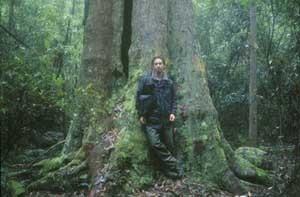
.
.
‘Fuel reduction burns threaten species’ – or Black Saturday incompetence an excuse for broadscale State Arson
[Source: Peter Vaughan, Monash University, Melbourne, 20100531,^http://www.reportage-enviro.com/2010/05/fuel-reduction-burns-threaten-endangered-species/]
.
‘Conservationists are concerned that fuel reduction burns in East Gippsland will threaten endangered species and reduce biodiversity.
On March 16, fire managers from the Department of Sustainability and Environment (DSE) ignited a fuel reduction burn in the Dinner Creek catchment of Waygara state forest, approximately 14 km West of Orbost. The fire quickly gained intensity, aided by a temperature of 30 degrees Celsius. It burnt most of the environmentally sensitive vegetation within the fire zone along four kilometres of the Dinner Creek.
DSE Fire Manager for the Orbost Region, Steve de Voogd, said that the Dinner Creek fuel reduction burn grew hotter than intended. The fire was meant to burn 2206 hectare of coastal forest and leave a mosaic of burnt and un-burnt areas within the fire’s containment lines.
.
According to Mr de Voogd, the DSE is now under community pressure to reduce the risk of wildfire through fuel reduction burning, and that must take precedent over ecological considerations.
.
“Although there is probably room for more fire ecology planning, it is incumbent on the DSE to take action because the consequences of doing nothing may be worse,” Mr de Voogd said.
Most of the hollow bearing trees in the burn zone, which were home to a number of endangered species protected under state and federal law, were destroyed.
Dr Rohan Bilney, an expert on Australian forest owls and spokesperson for the Gippsland Environment Group, said that the program intended to burn large areas of coastal forest without adequate ecological planning, monitoring or research, which threatened crucial habitat and food sources for the forest’s owls species.
.
“The coastal forests of East Gippsland are the strong hold of the Masked Owl, a species listed as threatened under two laws: the Victorian Flora and Fauna Guarantee Act and the Federal Environmental Protection and Biodiversity Conservation Act. Most of East Gippsland’s Masked Owls live in the coastal forests now being subjected to intense broad area fuel reduction burns by the DSE,” said Dr Bilney.
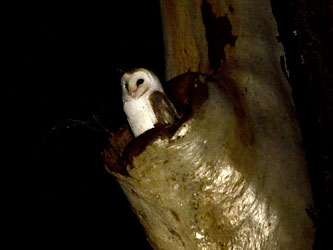
Masked Owl (Tyto novaehollandiae)
.
The Masked Owl Action Statement, prepared under the Victorian Flora and Fauna Guarantee Act, estimates only 150 pairs of Masked Owl exist in Victoria. Of that total, 100 pairs are found in East Gippsland and most are concentrated in the coastal forest.
DSE Manager of Biodiversity in East Gippsland, Dr Steve Henry, said that the current DSE fuel reduction fire strategy allows for large fires but burning on such a scale leaves few options for the protection of important ecological values.
“If there are some areas that contain specific environmental attributes that we want to protect, we could exclude them from fire with a bulldozer line. However that is expensive and often very destructive on most of these large burns. The main management technique used is the way in which the lighting pattern of the fire is done, sometimes that is not as effective as we would hope,” he said.
Mr Henry said that funding constraints have not permitted the DSE to conduct detailed ecological studies of the coastal forests, including the effect of fire on the environment.
A post-fire ecological survey is currently being conducted by the DSE in selected fuel reduction areas.
The Dinner Creek fire was just one of 48 fuel reduction burns planned by the DSE for the region during 2009-2010. Like other fuel reduction burns, the DSE must comply with the Victorian Code of Practice for Fire Management on Public Land.
The primary objective of the Code is to protect of life and property, while minimising negative impacts on natural and cultural values, and abiding by threatened species legislation, are also included.
The Code of Practice also states that the DSE must prepare a Fire Ecology Strategy that includes input from ecological experts and full consideration of all available scientific research.
If little ecological research exists, fuel reduction burning can be conducted under the rational that it may reduce the future risk of wildfire.
.
In the absence of scientific data, the DSE will continue to plan fuel reduction burns from computer desktops, utilising the ad hoc data collected as part of the Environmental Vegetation Class mapping projects of the late 1990s.
While political pressure continues to increase, the DSE fire policy will remain focused on protecting the community against the spectre of Black Saturday.’
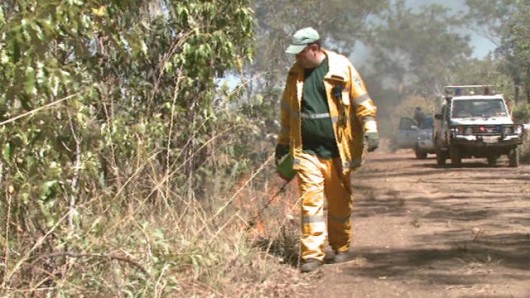 Burn it in case it burns, because we don’t have the resources for wildfire suppression Burn it in case it burns, because we don’t have the resources for wildfire suppression
.
.
‘Climate change, fires and logging -the deadly combination for Victoria’s species’
[Source: Environment East Gippsland, ^http://www.eastgippsland.net.au/?q=node/446]
.
‘Two hundred years ago the Sooty owl was abundant and fed on about 18 species of ground prey in Gippsland. Today they have only two or three to chose from. Other species are under similar pressure.
Many of our native animals have become sparser in numbers and their range has shrunk. Some, like the Southern Brown Bandicoot (Federally listed but not State listed), are now isolated in small “island” populations which are dangerously close to extinction mainly due to threats of fire and predation. Fires destroy understorey cover, making it easy for foxes and dogs to wipe out small populations of ground dwelling animals.
The 2003 fires and the recent December ’06 fires have destroyed the habitat and ground cover over about 2 million hectares of Victoria’s forested country. This has had a horrifying impact on ground mammals, birds and hollow dependent species.
.
Scientist and Quoll expert, Dr Chris Belcher, has calculated that this species’ Victorian numbers were reduced by 33 – 45% as a result of the ’03 fires. The December ’06 fires would have reduced this again to even more precarious numbers.
The isolated colony of Long Footed Potoroos discovered around Wonangatta (or Wongongara?) will most likely have been killed as a result of the recent fires.
The Helmeted Honeyeaters had five small and isolated populations left but the 1983 fires wiped out four of them. Yellingbo is still likely to burn and our faunal emblem will be extinct on this planet.
Bandicoots are very fire sensitive. There are small and vulnerable populations scattered in Gippsland. In 1994, fires burnt 97% of the Royal National Park and Bandicoots no longer survive in this area. The safety of thick ground cover does not return for years, meaning foxes and dogs heavily predate any survivors.
.
East Gippsland is the last stronghold for many of our rare and endangered fauna. It is a wetter environment and has much higher floristic diversity and therefore animals.
Climate change will now make fires more frequent and intense in SE Australia (CSIRO). Governments must adapt management of natural areas to account for this reality as it is for agriculture, water and energy.
The greatest pressure on Eastern Victorian species has been in the Critical Weight Range from 35 gms to 5 kg. Many ground dwelling animals are extremely susceptible to fire. Potoroos, Quolls, Bandicoots, native rodents (the rare New Holland Mouse, Smokey Mouse etc).
The predation rate after a fire is huge and patches of unburnt forest within the fire zones are absolutely essential to help populations survive predation, recover and disperse in time. These areas are critical to protect from further disturbance.
The recovery of species after a fire is now very different from 200 yrs ago. Populations are more isolated, salvage logging further destroys their chances, there is less diversity of prey species for the higher order predators like owls and quolls to turn to if gliders and possums are impacted by fires (or logging the hollow-rich forests).
Logging ecologically diverse forests favours the return of biologically poor tree communities such as silvertop and stringybark. The forests with mixed gum and box throughout can have 20-50 times higher animal densities. Significant vegetation changes due to massive landscape disturbance such as clearfelling, makes endangered species recovery from fire even more unlikely.
In the 1990s, East Gippsland supported seven times more threatened species than other areas in Victoria. This made the region seven times more important for our endangered species’ survival. Since the fires of 03 and 06, it is not unreasonable to suggest that East Gippsland is the last refuge and last chance for these species to survive extinction. Extinction can happen very quickly.
Species which are fairly general in their roosting, nesting and feeding needs can often survive (as they have in other areas of the state) but the many specialist species which rely on large areas of diverse and thick forest are highly likely to vanish forever.
This is why the hasty and unscientifically mapped areas of newly reserved forest require careful refinements. The needs of the state’s threatened species must be made the priority. Independent biologists and on-ground local knowledge (not VicForests) must be used to finalise the new reserve boundaries, with the long-term impact of the recent fires as a major guiding factor.
The Bracks Government suggested there be no net loss of resource as an adjunct to the mapped reserve areas. This is an impossible and irrational qualification as fires can take out large percent of the forest and therefore wood resources in one season. Commercial use of forest should be allocated only after biologically essential considerations have been adequately addressed.
Another point made in pre-election promises was to make sure the new areas are mapped and industry changes are resourced so as to adhere to the terms and spirit of the RFA. This then should see the government honour its long overdue commitment to carry out research into the impact of clearfelling on threatened species, to identify sustainability indicators, carry out five yearly reviews and ensure threatened species are protected. None have been honoured in the last 10 years!
The recent court ruling regarding the EPBC Act should also give the state government substantial opportunity to begin to alter protection measures for Federally listed species in East Gippsland.
The conscience of this government cannot put the very limited future of several sawmills ahead of a large number of entire species. Continued logging of intact original forests must not be the overriding priority. The ability for species to cope with the escalating impacts of climate change and fires from 2007 onwards has to now be put ahead of politics and union threats. These species survived well in Australia for over 40,000 years. The clearfell logging industry has been around for less than 40 years. Political priorities have an even shorter lifespan.’
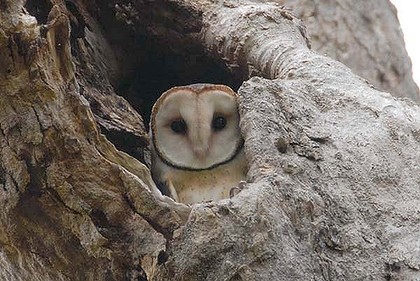
.
.
Further Reading:
.
[1] ^ http://eastgippsland.net.au/files/Sooty_Owl_%20Powerful_Owl_Bilney_December_2009.pdf , [ Read Report]
[2] Environment East Gippsland website, ^ http://www.eastgippsland.net.au/
[3] ‘ Sooty Owl Action Statement‘, Victorian Department of Sustainability and Environment (DSE), [ Read Statement]
[4] ‘ Powerful Owl Action Statement‘, (DSE) ^ http://www.dse.vic.gov.au/__data/assets/pdf_file/0019/103177/092_powerful_owl_1999.pdf , [ Read Statement]
[5] ‘ Masked Owl Action Statement‘, (DSE), ^ http://www.dse.vic.gov.au/__data/assets/pdf_file/0015/103173/124_Masked_Owl_2001.pdf , [Read Statement]
[6] Victorian Rainforest Network website, ^ http://www.vicrainforest.org/
[7] The Southern Peninsula Indigenous Flora & Fauna Association Inc., ^ http://www.spiffa.org/victorias-biodiversity-crisis.html
[8] ‘Protecting Victoria’s Powerful Owls’, ^ http://www.dse.vic.gov.au/__data/assets/pdf_file/0012/102144/PowerfulOwls.pdf , [ Read Report]
[9] ‘ Fire Protection Plan Gippsland Region‘, 2011, ^ http://www.dse.vic.gov.au/fire-and-other-emergencies/fire-management/fire-protection-plans/fire-protection-plan-gippsland-region , [ Read Plan]
[10] ‘ North East Victoria: Biodiversity‘, Australian Department of Agriculture, Fisheries and Forestry, ^http://www.daff.gov.au/__data/assets/pdf_file/0007/63583/Environmental_Values.pdf , [ Read Report]
[11] ‘ Submission to East Gippsland Forest Management Zone Amendments September 2010‘, ^ http://vnpa.org.au/admin/library/attachments/Submissions/EG%20Zoning%20Review%20Joint%20Submission%20ENGO%20Groups.pdf , [ Read Report]
[12] ‘ Ecology and conservation of owls‘ by Ian Newton, ^ http://www.publish.csiro.au/pid/3152.htm
.
Tags: DSE, Flora and Fauna Guarantee Act, fuel reduction program, habitat trees, hazard reduction, hollow trees, hollow-dependant fauna, Masked Owl, Powerful Owl, prescribed burning, Sooty Owl, State Arson, State Logging, VicForests, Victoria's old growth forests, Victorian Bushfires Royal Commission, Victorian Department of Sustainability and Environment
Posted in Gippsland (AU), Owls, Threats from Bushfire, Threats from Deforestation | No Comments »
Add this post to Del.icio.us - Digg
Wednesday, October 26th, 2011
It’s past time that the barbaric and backward chinese culture of Traditional Chinese Medicine (TCM) was recognised by the world’s civilized countries for what it is, an evil cult against wildlife, and so criminalised along with Female Genital Mutilation forthwith. Neither serve any purpose except barbaric harm.
TCM superstition claims that rhino horns cure typhoid fever, convulsions, cancer, rheumatism, gout, snakebites, hallucinations, headaches, carbuncles, vomiting, food poisoning, and ‘devil possession’. What backward quackery! Even the the rhino’s skin and faeces is used by TCM witchdoctors. Being superstitious and backward is one thing, but such ludicrously is driving and perpetuating the chinese illegal wildlife poaching of rhinos and elephants for their horns. Is this why the chinese regime is spreading its influential tentacles across Africa?
 Dried Tiger bone, Moon Bear bile, ground Elephant horn
All packaged and sold in an innocuous TCM grocer,
belying the world’s most barbaric cult against wildlife Dried Tiger bone, Moon Bear bile, ground Elephant horn
All packaged and sold in an innocuous TCM grocer,
belying the world’s most barbaric cult against wildlife
.
Today we learn that the last Javan rhino subspecies in Vietnam was found poached for its horn. It is now extinct.
The Javan rhino is Critically Endangered on the IUCN Red List of Threatened Species. In 2009 only ten individuals of the subspecies Rhinoceros sondaicus annamiticus remained in South Vietnam’s rainforest region.
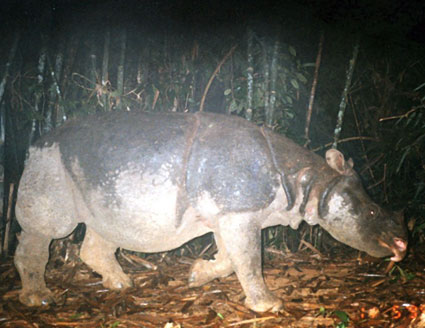 Javan one-horned Rhinoceros extinct as from yesterday due to poachers paid by the TCM witchdoctor cult Javan one-horned Rhinoceros extinct as from yesterday due to poachers paid by the TCM witchdoctor cult
.
‘Vietnam has lost its fight to save its rare Javan rhinoceros population after poachers apparently killed the country’s last animal for its horn, pushing one of the world’s most endangered species closer to extinction, a conservation group (World Wildlife Fund) said Tuesday (25th October 2011).
Vietnam’s Cat Tien National Park has had no sightings, footprints or dung from live rhinos since the last known animal living there was found dead last April, shot through the leg with its horn chopped off, the WWF said. Genetic analysis of rhino feces had confirmed in 2004 that at least two rhinos were living in the park, raising hopes that Vietnam’s population might survive.
Only 40 to 60 Javan rhinos now remain in Ujung Kulon National Park in Indonesia. They are the last known living members of the species, with none in captivity.
Vietnam’s Javan rhino population had been shrinking for decades as land conversion and a rising local population threatened the animal’s habitat, but poaching and a lack of effective park management and patrols hastened the decline, said Christy Williams, coordinator of WWF’s Asian Elephant and Rhino Program.
“It appears that protection is not being given a high priority by the Vietnamese government,” he said. Park director Tran Van Thanh said that while some of his rangers failed to fulfill their duties, it is impossible for them to stop all of the estimated 100,000 people living near the park from hunting exotic animals when the average farmer there earns around 150,000 dong ($7.50) per day.’
[Source: ‘Javan rhino goes extinct in Vietnam after last rhino poached‘, by Mike Ives, Associated Press, 20111026, ^http://www.csmonitor.com/World/Latest-News-Wires/2011/1026/Javan-rhino-goes-extinct-in-Vietnam-after-last-rhino-poached]
.
The subspecies Rhinoceros. sondicus inermis once found in Bengal, Assam, and Myanmar is now extinct. The subspecies Rhinoceros sondaicus sondaicus lives only in Ujung Kulon National Park, Java, and has less than 60 individuals remaining.

All these TCM potions and remedies contain a small amount of Rhinoceros horn
© Esmond Bradley Martin
.
The Yin and Yang philosophy may suggest a wholesome healthy balanced approach to alternative medicine, but according to the Australia Herbal Medicine Centre (a Chinese run practice in Sydney’s Chinese-centric Ryde)..”Chinese Herbal Medicines are mainly plant based, but some preparations include minerals or animal products.”
“Some of the conditions which may be treated by Chinese Herbal Medicine include:
- Chronic headaches
- Skin disorders
- Irritable bowel syndrome
- Constipation and diarrhoea
- Insomnia and fatigue
- Common cold and influenza
- Anxiety, depression and stress
- Allergies
- Rheumatoid and osteoarthritis
- Premenstrual syndrome and painful menstruation
- Excessive menstruation
- Infertility
- Impotence and prostate disorders
- Disorders associated with menopause
- Loss of appetite and common digestive disorders
- Fluid retention”
.
This all sounds impressive, but question is: Which remedies contain wildlife parts and so require illegal poaching? …sorry not on the label?
.
TCM is an evil backward cult inciting wildlife poaching and the key driver of wildlife extinctions around the globe. TCM ethically needs to be immediately banned, its barbaric practices made illegal and its products containing animal parts declared illegal wildlife trafficking and so an illegal import. Poaching endangered animals is far worse than mass slaughter of non-endangered animals or even the mass slaughter of humans. Species Extinction is the worst crime on the planet, because a whole species is threatened with extinction, not just a few million humans or so out of 7 billion.
.
The Sydney Institute of Traditional Chinese Medicine [http://www.sitcm.edu.au/] needs to immediately and publicly renounce any use of wild animal parts in its practice, else be immediately criminalised as an ecologically destructive cult.
Rhino Horn is not medicine – chew your nails instead. Go and see a real doctor!
.
.
.
Further Reading:
.
[1] ^ http://www.csmonitor.com/World/Latest-News-Wires/2011/1026/Javan-rhino-goes-extinct-in-Vietnam-after-last-rhino-poached
[2] ^ http://newswatch.nationalgeographic.com/2009/11/23/dogs_sniff_out_rhinos_of_vietanm/
[3] ^ http://www.asianscientist.com/topnews/wwf-traditional-chinese-medicine-rhino-horn-cancer-cure-cites-meeting/
[4] ^ http://www.guardian.co.uk/environment/video/2011/oct/25/javan-rhino-extinct-vietnam-wwf-video?newsfeed=true
[5] ^ http://www.rhinoconservation.org/2010/01/15/is-surge-in-illegal-rhino-horn-trade-linked-to-chinas-designation-of-tcm-as-strategic-industry/
[6] ^ http://www.treehugger.com/files/2011/01/does-protecting-endangered-rhinos-conflict-with-traditional-chinese-medicine.php
[7] ^ http://www.greenfudge.org/2011/08/22/tcm-quackery-fuels-brutal-rhino-poaching/
[8] ^ http://www.sciencebasedmedicine.org/index.php/asian-bear-bile-remedies-barbarism-or-medicine/
[9] ^ http://www.abc.net.au/news/2010-02-06/female-circumcision-happening-in-australia/2594496
.
Tags: Australia Herbal Medicine Centre, backward chinese, evil cult, Female Genital Mutilation, illegal wildlife trade, Javan Rhino subspecies extinct, rhino poaching, Rhinoceros sondaicus annamiticus, Sydney Institute of Traditional Chinese Medicine, TCM, TCM witchdoctor cult, Traditional Chinese Medicine, Tran Van Thanh, Ujung Kulon National Park, Vietnam Rhino extinct, wildlife extinction, world's most barbaric cult, WWF's Asian Elephant and Rhino Program
Posted in Africa, Rhinoceroses, Threats from Poaching and Poisoning | No Comments »
Add this post to Del.icio.us - Digg
Wednesday, October 26th, 2011
This article was initially published by Tigerquoll 20090514 on CanDoBetter.net:
.
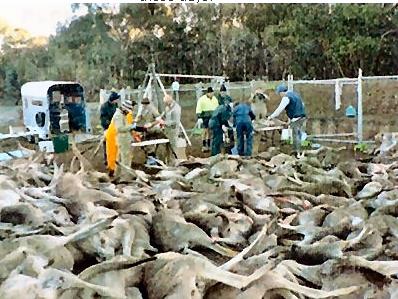
.
Australia’s Defence Minister, Joel Fitzgibbon MP, has just been handed AUD$26,950,000,000 to unjustifiably escalate Australia’s military aggression, at a time when Federal Treasurer Wayne Swan says the world economy is gripped by the worst recession in 50 years.
Labor’s 2009 Defence White Paper indulges to the extreme, planning for so-called “Defence” (against what?) to receive some $146 billion in additional funding across the life of the White Paper to 2030.
Hypocritically at the same time, Fitzgibbon has rejected spending just $3.5 million to save thousands of Australia’s grey kangaroos fenced in on Defence land at Majura training range just outside Canberra. And at a time when Federal MPs have just awarded themselves another pay rise of $4000 pa for ‘electoral allowances’. It all stinks like British Parliamentary abuses.
Australia’s kangaroos, stressed from people altering their habitat, have been denied their freedom to roam their traditional grazing lands due to it being bulldozed for selfish property development, due to drought, consistent shooting and from uncontrolled bushfires.
Despite wildlife ecologist Dr Dror Ben-Ami telling the review tribunal that the Defence Department has no assessments of any impacts caused by the kangaroos nor that the kangaroos pose any threat to any threatened species on the Majura range, Fitzgibbon has condoned the senseless slaughter of 4000 of a population of 9000 trapped kangaroos be shot in secret, just last Saturday, 9th May 2009. Fitzgibbon approved a similar massacre just on a year ago at the same place – it must be some idea of a sick sport to him!
Fitzgibbon says it is to reduce the kangaroos to ‘sustainable levels‘.
How’s the language?
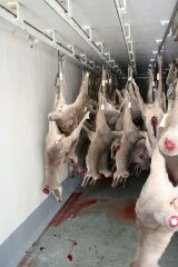 How is this mass killing different to April 1994 when the Hutu militia hacked thousands of Tutsis to death in Rwanda, or July 1995 in Srebrenica when Serb General Ratko Mladic systematically selected and then massacred 8,372 men and boys ‘of fighting age’ (between the ages of twelve and sixty), or in May 2000 when the Sri Lanka Army used banned cluster bombs from China, multi barrel rocket Launchers killing 2,000 Tamil civilians in the island’s north? How is this mass killing different to April 1994 when the Hutu militia hacked thousands of Tutsis to death in Rwanda, or July 1995 in Srebrenica when Serb General Ratko Mladic systematically selected and then massacred 8,372 men and boys ‘of fighting age’ (between the ages of twelve and sixty), or in May 2000 when the Sri Lanka Army used banned cluster bombs from China, multi barrel rocket Launchers killing 2,000 Tamil civilians in the island’s north?
Just four days ago, 378 Tamil civilians were killed after Sri Lankan forces fired a massive barrage of artillery shells at Tamil Tiger rebels. Again the UN stands by – bit like how Pope Pius XII stood back while Hilter’s Nazis massacred millions of Jews during WWII.
In these human massacres, the killers use propaganda to describe their victims such as ‘terrorists’, ‘militants’ and justfity the massacres as ‘ethnic cleansing’. In each of the above human massacres, the UN has stood back and watched.
Like these human massacre, thousands of Australia’s iconic kangaroos, have just as much right to life as humans, yet they are been similarly slaughtered in secret. Defence uses fabricated propaganda like the kangaroos being in “plague proportions” and “hordes” and “pests”, that their “populations have exploded”; that they “compete for pasture”; and the latest ludicrous example; “they are eating endangered species of grass”. All so as to spin the sick aim of “sustainable culling”.
It’s simply a ecological massacre. It has just been done in secret with approval of Joel Fitzgibbon.  How is he any different to Sri Lankan Defence Secretary Gotabhaya Rajapaksa? How is he any different to Sri Lankan Defence Secretary Gotabhaya Rajapaksa?
This tragic massacre deserves to be written into Australia’s history as……’Fitzgibbon’s Massacre‘.
.
.
.
Further Reading:
.
[1] ‘ Roo cull eases pressure on reserves‘, by Margaret Burin, ABC Local, 20110628, ^ http://www.abc.net.au/news/stories/2011/06/28/3255317.htm?site=canberra
‘Nearly 2,500 kangaroos were killed during the three week cull in Canberra’s nature reserves….’
.
[2] ‘ Kangaroo Shooting: the largest land-based commercial wildlife slaughter in the world‘, by Animals Australia, ^ http://www.animalsaustralia.org/issues/kangaroo_shooting.php
‘Each night in remote areas of the Australian outback thousands of kangaroos graze peacefully, stand up on hearing an approaching vehicle, stare into a blinding spotlight, and are shot for their meat and skins.
The commercial kangaroo kill ‘quota’ for 2009 (the number permitted to be killed) is just under 4 million kangaroos….’
.
[3] ‘ New Report Exposes the Grubby Reality of the Kangaroo Industry‘, by Animals Australia, ^ http://www.animalsaustralia.org/issues/kangaroo_shooting.php
‘A new report ‘A Shot in the Dark – a report on kangaroo harvesting’, commissioned by Animal Liberation (NSW) was released in May 2009
outlines problems of hygiene in the kangaroo meat industry, sustainability of kangaroo populations and animal welfare. The report estimates some ‘440,000 dependent young kangaroos are either clubbed to
death or left to starve after their mothers are killed’. Read Report: ^http://www.kangaroo-protection-coalition.com/shotinthedark.html
.
[4] ‘ Australia officials want to kill 3,000 kangaroos‘, by Rob Griffith, Associated Press, 20070514,^ http://www.msnbc.msn.com/id/18656748/ns/world_news-
asia_pacific/t/australia-officials-want-kill-kangaroos/#.Tqb-pbKLNhU
‘CANBERRA, Australia — Authorities said Monday they want to shoot more than 3,000 kangaroos on the fringes of Australia’s capital, noting the animals were growing in population and eating through the grassy habitats of endangered species.’
A cull of about 800 kangaroos in the Canberra area in 2004 also brought a large outcry from animal activists. In 2003, authorities ordered the killing of 6,500 eastern grays at the Puckapunyal military base, 62 miles north of Melbourne. A year earlier,
a similar shooting operation killed more than 20,000 kangaroos on the base.’
.
[5] ‘The life and death of Kangaroos‘, by Ray Drew May 2008, ^http://www.kangaroolives.com/inhumanity.htm
‘On Monday May 19, 2008, government contractors started killing the kangaroos on a former naval base in Canberra, Australia. By May 29 they (514) were dead. This, in a diary in reverse, is their story and the fight to save them. ALL OF THE KANGAROOS IN THE PHOTOGRAPH ABOVE ARE NOW DEAD. THEY WERE NEEDLESSLY KILLED IN THE LAST WEEK OF MAY 2008, following a world wide campaign to save them….’
.
Tags: Australia's grey kangaroos, Canberra, Defence Department, Fitzgibbon Massacre, Joel Fitzgibbon, kangaroo cull ACT, kangaroo slaughter, kangaroos shot Canberra, Majura Training Area, roo shooter
Posted in Kangaroos and Macropods, Threats from Poaching and Poisoning | No Comments »
Add this post to Del.icio.us - Digg
Tuesday, October 25th, 2011
This article was initially published by Tigerquoll onCanDoBetter.net on 20090524:
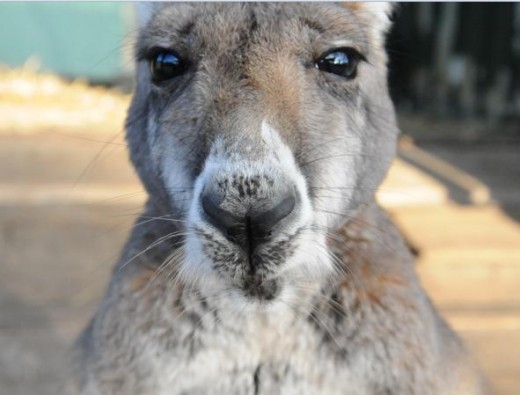 Australia’s native kangaroo – targeted by poachers and mass slaughter encouraged by Australian governments
Australia’s native kangaroo – targeted by poachers and mass slaughter encouraged by Australian governments
.
The Australian outback town of Mitchell lies in the Western Downs region of southern Queensland on the Warrego Highway just shy of 600 km west of Brisbane on the way to Charleville. Situated on the Maranoa River, the town of Mitchell was named in honour of the 19th Century explorer, and the town emerged as a pastoral town out of the farming of grains, beef and sheep. Tourism has become a strong drawcard to Mitchell and especially to its Great Artesian Spa.
But more recently, Mitchell’s fame has been lowered to infamy with it taking on a reputation for becoming the home of the kangaroo slaughter trade.
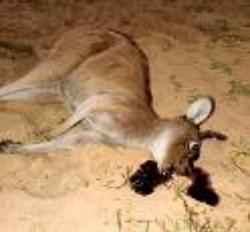 . .
“You see a lot of utes in Mitchell and the towns just like it that emerge from the roadside only to disappear again as you drive west through southern Queensland on the Warrego Highway. You can tell the ones that are driven by kangaroo shooters. They have racks for guns and long spikes upon which the freshly eviscerated carcasses are placed. One, parked just around the corner, has black steel bullbars with the words “roo raper” cut into them.”
.
‘Besides the slaughter of Australia’s iconic kangaroos for pet meat and indeed export for human consumption in fancy restaurant,
it is the sanitary conditions that is shocking and a life threatening time bomb’
.
Following the international biolab standards of Silliker, animal liberation chief, Mark Pearson says “the last time we did swabs here and in Charleville, they were alarmingly high in E.coli.“
‘The chiller doors aren’t locked. When Ben-Ami opens the first, problems are immediately apparent. Bright drips from fresh kills are spotting onto another layer of older, duller, deader blood, which is particularly thick nearest the front. The lip of the door frame is so thick and sticky, the red’s turned a dull, dark brown. Hairs are stuck to it.
.
‘The carcasses are packed as tightly as possible.
They hang from hooks by their legs,
their heads and tails missing,
gaping rents where their stomachs once were,
leg muscles tensed visibly;
severed necks poke into gut cavities;
hundreds of paws hang in a grisly reach towards the bloody floor.
According to their tags,
they’re four days dead.’

“These are quite young ones, heads cut off quite low,” Pearson says, pointing to a nub of spine that’s jutting out just above the shoulder.
“Most of them are cut too far back.” To decapitate in this way requires significantly more effort than using the traditional method, with a slice directly beloiw the jawline. It also makes bad financial sense to remove most of the neck , as harvesters are paid by weight. Proof, claim the activists, that an illegal shot in the jaw or neck has been covered up.
‘Pearson points to the floor. “They’re bringing in new carcasses and hanging them above the floor, which has blood from old carcasses. Blood is a Petri dish for disease and contamination. This is a major breach of any export abattoir standards.” he points to a small grey kangaroo that is caked elbow to paw in blood and dirt. “That’s from the evisceration,” he says. That’s all supposed to fall to the ground. And don’t forget, these would have been on the back [of a ute] for four, five, six hours, and it would have been 20 degrees. When you consider this is export meat…Uh-oh…”
Besides Mitchell, the roo rapers store their roo chillers at Charleville, Augathella and Blackall. The practice in outback Queensland is widespread.
To struggling towns in the outback like Mitchell, kangaroo meat is big business. “The Kangaroo Industry Industry Association of Australia says theirs is a business worth $270 million a year that directly employs about 4000 people” many in remote areas.”
[Source: Sydney Morning Herald, Good Weekend magazine, 20090523]
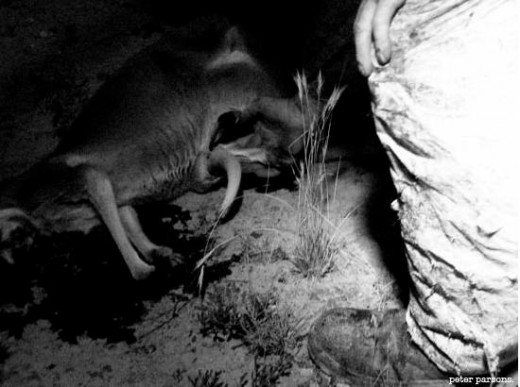
.
AusHunt, a website dedicated to hunting in Australia and it’s hunters, advocates:
.
“Kangaroo shooting is a unique job and many people are involved in one way or another in Australia’s kangaroo industry. My advice for the wannabe ‘roo shooter? You’ll need to make a few phone calls to chiller-box operators in various rural centers to evaluate the impact another ‘roo shooter would have there. Then decide on a location.
Before doing anything, take a week off work and go out with a qualified, professional ‘roo shooter and see what is actually involved.
Australia’s kangaroo industry is one of the only jobs in the world where a person can legally shoot wild animals full-time for a living.
Kangaroo shooting is a tough life with long hours, and a certain danger element. Depending on weather conditions (wind, rain), phases of the moon and drought, the kangaroo shooter may have a good or bad night. It can be a very irregular income earner.
Many shooters struggle to make money, some make a living, and a few make good profits of A$100,000/annum +. Dedication is the name of the game …. going out night after night and avoiding the temptations of the local pub. The upside is that the shooter is very independent and can lead an exciting outdoors life, totally using his wits, determination and shooting prowess to make money.
Okay, you like what you see and you’ve done your courses. Move to the rural center that you have selected and get a day job there, whether it be pumping gas or whatever. Then, start looking around for properties on which to shoot and start off by shooting week-ends. See how you go, then move on to fulltime when you know that you can make money. Good luck!”
.
.
‘Kangaroo harvesting under the spotlight’
.
Animal welfare activists are hoping public outrage over the slaughter of cattle in Indonesia can be redirected towards a new target – the commercial harvest of kangaroos. But activists’ involvement with research at the University of Technology, Sydney (UTS), has sparked a major scientific blue.
A year ago, animal welfare group Voiceless established THINKK at UTS, specifically to oppose the commercial kangaroo harvest. The unit’s lead scientist, ecologist Dr Dror Ben-Ami, says a lot of information about the kangaroo industry is misrepresented and not researched thoroughly.
This year, the national quota for the commercial harvest of kangaroos is set at around 3.7 million animals, but Dr Ben-Ami fears the real toll may be much higher.
“We estimate that up to a million dependent young are killed inhumanely every year as a result of the kangaroo industry,” he said.
“Those numbers come from industry statistics, in the sense of how many females are killed every year, and from behavioural reproductive ecology knowledge about how many young each female will have.”
There are in fact no industry figures on how many joeys are killed. Their main protection is the commercial shooters licence, which bans the hunting of females with dependent young.
Professor Mike Archer, the dean of science at the University of New South Wales (UNSW), says shooters are aware female kangaroos may be carrying joeys.
“There is an effort made by the shooters. They’re aware of this issue,” he said. He has raised questions about the research being done by THINKK.
“If a group like that were actually based in my university, in the University of New South Wales, we would be having a very serious think about whether they actually belong there,” he said.
“If they publish their own papers, refereed their papers themselves, didn’t quote real experts in the field, we would be very uncomfortable if they were operating in UNSW.”
.
Hygiene fears
.
Adult kangaroos are shot by night and driven to chillers the next day for processing, leading to another of THINKK’s major concerns – the hygiene of the meat.
In early 2009, Animal Liberation collected samples from unlocked outback chillers, which tested positive for E. coli and salmonella. Several months later, major export destination Russia slapped a ban on kangaroo meat, citing contamination fears.
“If one ate kangaroo meat with high levels of E. coli, you’d have a upset stomach – that would be the case with most people,” Dr Ben-Ami said.
Animal Liberation went on to set up new lab tests of supermarket meat. Dr Ben-Ami says the findings are concerning.
“The results have shown very high levels of E. coli, above alert levels of 1,000 colony-forming units and also a couple of samples came back positive for salmonella,” he said.
There are hundreds of different kinds of E. coli, but only some can be toxic. Animal Liberation’s tests did not establish whether the E. coli found in the kangaroo meat was dangerous.
But UNSW researcher Rosie Cooney says Dr Ben-Ami’s concerns about the contamination of kangaroo meat are overstated.
“A large study done some years ago that looked at over 200,000 carcasses found in fact that the rates of rejection for contamination of kangaroo carcasses were actually considerably less than those for sheep,” she said.
Science ‘under siege’
Dr Cooney and her colleagues believe when it comes to the commercial harvest of kangaroos, the science is now under siege. This has spurred them into action, with a national group of scientists about to publish a critique of THINKK’s claims.
This group says the research proves there is great environmental benefit in encouraging farmers to harvest kangaroos for profit.
“They’re then going to want to value those animals, keep them on their land and importantly, maintain the habitat, the native vegetation, for those creatures as well,” she said.
Dr Ben-Ami says his critics should “write back and engage in academic dialogue, rather than smearing”.
THINKK has today released a new paper arguing against the kangaroo harvest on animal welfare grounds. Their key claim is that that shooters are missing the mark and joeys are being left to die.
[ Read Paper]
“We’re taking a native animal out of its natural habitat in great numbers every year and thinking that that has no ramifications, and I think that’s absurd,” he said.
With both sides claiming the science is on their side, the challenge for animal welfare groups is to get kangaroos off the menu.
..
[Source: ‘Welfare Activists Target Kangaroo Industry‘, by Sarah Dingle and staff, 20110713, ABC Western Queensland, ^http://www.abc.net.au/news/2011-07-13/welfare-activists-target-kangaroo-industry/2793878/?site=westqld, accessed 20111025]
.
.
Would you eat this animal?
.
Natural resources are at the heart of the booming Australian economy. In particular, the country’s success in selling these economic growth goodies to a ravenous China has transformed the Aussie economy.
China is today Australia’s largest trading partner, buying up iron ore, coal, natural gas, and other industrial minerals to the tune of $55.2 billion a year — or more than 20 percent of Australia’s total exports. So it’s not too surprising that some entrepreneurial Australians want to add another natural resource to that growing list: kangaroo meat. Australia is crawling with the creatures. And China is apparently hungry for them.That’s the plan, anyway, according to this fine feature story from Matt Siegel in the New York Times.“The Chinese have a strong culinary tradition in using wild foods, not just meat, but a wide range of wild foods called yaemei in Cantonese and yewei in Mandarin,” John Kelly, executive director of the Kangaroo Industry Association of Australia, a lobbying group, told Siegel. “Kangaroo will to a large extent just slot right into that existing tradition in much the same way it has in the European markets.”
China sent a government delegation to Australia last December to investigate the health and sanitary conditions of kangaroo producers, the New York Times reports.
And not without reason. Kangaroo meat has come under increasing scrutiny following an E. coli outbreak in 2009, which led to a ban from kangaroo-scarfing Russia. The health scare also triggered a collapse of kangaroo meat exports, which tumbled from $38.4 million in 2008 to just $12.3 million last year.
But the new plan to sell kanga-meat to China comes with other challenges. First off, kanga meat is a hard sell — even to Australians. According to a 2008 study cited by the New York Times, just 14.5 percent of Australians have “knowingly” eaten kangaroo meat, versus the 80 percent who eat beef.
The problem? Kangaroo meat has been commonly used as pet food and as skins for clothing. Moreover, many Aussies view the country’s 25 million roos —who outnumber the 23 million human Australians — as large, destructive, and sometimes dangerous pests.
But the bigger challenge might be taste.
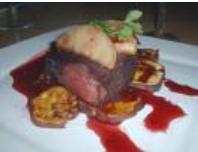
“It’s gamey — think beef plus arm pit,” says Freya Petersen, GlobalPost’s Breaking News Editor and our resident Australian staffer. “It needs to be cooked through but not over-cooked.”
“To me, it smells like pet food because we used to feed it to our dog and cat,” she adds.
Environmentalists and animal rights groups are also worried about the plan.
Australia’s kangaroo population “can’t even deal with the domestic and European consumption,” Nikki Sutterby of the Australian Society for Kangaroos told the New York Times. “How would it deal with a country as large as China starting to eat kangaroo meat?”
The kanga-meat crowd down under, however, remains undeterred.
“I’d expect us to be putting product into China at some time this year,” Kelly told the New York Times, adding that he expected China “at some stage to be a larger market than Russia ever was.”
.
[Source: ‘Would you eat thsi animal?’, by Thomas Mucha, 20110415, ^http://www.globalpost.com/dispatches/globalpost-blogs/macro/kangaroo-australia-china]
.
.
‘It sure ain’t Easy being Green! About the Kangaroo Coalition coordinator!’
by John Watson, Spectator News Magazine
.
‘Pat O’Brien became a greenie, and activist, in Condobolin 35 years ago when he saw kangaroos herded together, shot and clubbed to death. Until that moment, he had been “normal”.
The meatworker, who was working his way around Australia with his wife and three kids, did not think about the environment, probably dropped paper on the ground and just lived his own life. However, because of that sight of kangaroos being slaughtered, he has spent the next 35 years fighting for animals and the environment….’
READ MORE: ^http://www.kangaroo-protection-coalition.com/coordinator.html
.
Meanwhile, the Queensland Government tries to legitimise wildlife poaching by using euphemistic language…’The Department’s Commercial Macropod Management Program administers the commerical harvest of macropods in Queensland.’
.
^http://www.derm.qld.gov.au/wildlife-ecosystems/wildlife/wildlife_permits_and_licences/kangaroo_harvesting.html
‘It’s a poor farm that can’t sustain a few kangaroos.’
.
.
Further Reading:
.
[1] ‘ A Shot in the Dark‘, ^ http://www.wildlifeadvocate.com/pdf/a_shot_in_the_dark.pdf , [ Read Report]
[2] National Kangaroo Protection Coalition, ^ http://www.kangaroo-protection-coalition.com/
[3] THINKK (The Think Tank for Kangaroos), University of Technology Sydney, ^ http://thinkkangaroos.uts.edu.au/
[4] No Kangaroo Meat website, ^ http://www.nokangaroomeat.org/
[5] ‘ Kangaroo Harvesting under the spotlight‘, ABC TV ‘730 Programme’, 20110713, ^ http://www.abc.net.au/7.30/content/2011/s3268904.htm
[6] Australian Society For Kangaroos, ^ http://www.australiansocietyforkangaroos.com/not_so_green.html
[7] Read the original comments to the initial article by Tigerquoll on the CanDoBetter.net website: ‘ Kangaroo rapers of Mitchell (Qld) and the E.coli time bomb‘
.
.
Tags: Anna Bligh, Charleville, E. coli, export for human consumption in fancy restaurant, kanga meat, Kangaroo Industry Association of Australia, kangaroo meat, kangaroo meat hygiene, kangaroo pet food, kangaroo poaching, kangaroo slaughter trade, Mitchell, Queensland, Rolf Harris, roo raper, roo shooter, Russian kangaroo meat, THINKK, Warrego Highway, wildlife poaching
Posted in Kangaroos and Macropods, Threats from Poaching and Poisoning | No Comments »
Add this post to Del.icio.us - Digg
Tuesday, October 25th, 2011
The following article was initially posted by Tigerquoll as a comment on the Tasmanian Times 20100202:
.
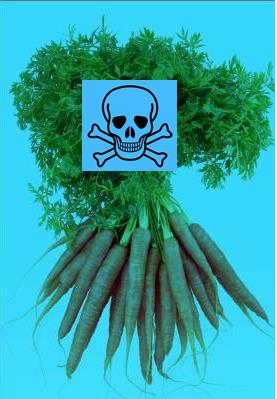 1080 ‘blue carrots’ 1080 ‘blue carrots’
.
Six years ago, the Tasmanian Greens tabled their Agricultural and Veterinary Chemicals (Control of Use) Amendment (Ban 1080) Bill 2004 to ban the use of 1080 poison (sodium monofluoroacetate) against native wildlife. But it excluded “persons directly employed with the Fox Task Force, up until the period ending 1 October 2006.”
‘Fox Task Force‘ …what a scam! Talk about dodgy jobs for mates at DPI. All they come up with is shit. It could be Drop Bear shit! They may as well be called it the Drop Bear Task Force and dress ’em up in black special forces attire and give ’em paint guns.
1080 must be banned in Tasmania outright including this fraudulent drop bear mob. I’d like to see an FOI on how much the taxpayer has funded them since they were set up. $10 million? We could have found a cure for the Devil’s face tumor or housed hundreds of homeless youth in Tasmania by now.
Tasmania’s “Department of Primary Industries and Water is the only importer of 1080 into Tasmania and only authorised officers of the Department handle the poison.” So the 1080 buck stps with DPI. DPI’s head needs to show cause, whoever the latest ‘acting’ secretary is! DPI has had so many name changes, ministers and bosses, DPI staff must be running the show. GM Environment was Warren Jones in October, so he can take the can, unless he’s been sacked as well.
According to DPI’s latest annual report, its Environment branch has a mission “to ensure best practice in environmental management and pollution control”…blah blah blah.
Well best practice in environmental management is exercising the precautionary principle, which in lay terms means if you’re not sure don’t intervene. Well ban 1080 until you can deliver a fox to the Hobart Town Hall!
.
.
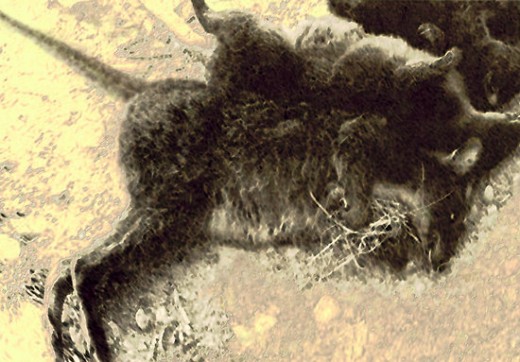 Tasmanian native Pademelons killed by 1080 poison
Source: http://www.redbubble.com/people/cradlemountain/art/3160948-why-is-1080-poison-not-good-for-tasmania-and-the-world Tasmanian native Pademelons killed by 1080 poison
Source: http://www.redbubble.com/people/cradlemountain/art/3160948-why-is-1080-poison-not-good-for-tasmania-and-the-world
.
‘By the year 2000, the Tasmanian Government poisoned 30 million native animals by allowing forest and farming industries to kill all marsupials (other species were sacrificed along with the slaughter).
Here I was collecting bodies and found nine different species affected, dead. This little female wallaby was clasping onto grass and had made a circle in the ground while dying in pain. I could not get the grass out of her little paws.’
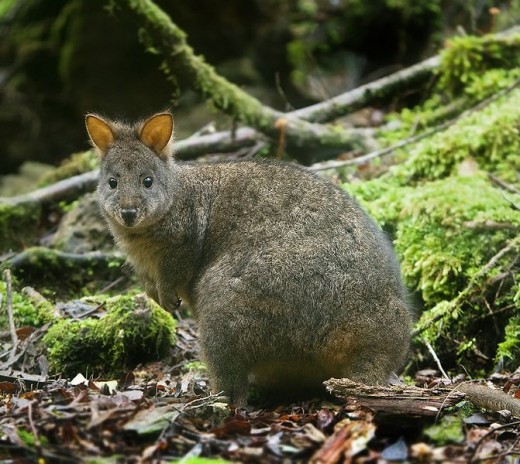 A live and healthy native Tasmanian Pademelon A live and healthy native Tasmanian Pademelon
.
.
1080 is immoral
.
1080 (sodium monofluroacetate) is a cruel and indiscriminate poison used to ‘remove’ unwanted populations of animals.
Banned in most countries, 1080 is still used liberally throughout Australia and New Zealand to control so-called ‘pest’ species, and reduce ‘browsing damage’ caused by native animals on private land. Its use is indiscriminate, which means that it kills not just the target feral animals but every animal in the area that eats off the forest floor.
1080 poison is a slow killer. When ingested (usually through baited food) the animal suffers a prolonged and horrific death. Herbivores take the longest to die – up to 44hrs, while carnivores can take up to 21hrs before finally succumbing to final effects of the poison. The speed of death is dependent on the rate of the animals metabolism.
.
A Slow & Horrific Death
.
Witnesses to the deaths of herbivorous animals, such as macropods, have reported:
“Affected wallabies were sometimes observed sitting hunched up, with heads held shakily just above the ground. Generally they appeared non-alert and ‘sick’, with shivering or shaking forelimbs and unsteady balance. Most individuals then experience convulsions, falling to the ground and lying on their backs and sides, kicking and making running motions with their hind legs before dying. Many individuals also ejaculated shortly before death, and, with others, exuded a white froth from their nostrils and mouth.”
Carnivorous animals such as dingoes, dogs, foxes, and cats become very agitated, as they tremble, convulse and vomit.”
[Source: ‘The World League for Protection of Animals’, ^http://wlpa.org/1080_poison.htm]
.
Also, 1080 is indiscriminate, it kills all carnivores including Devils, and endangered quolls and dogs.
“Under state poisons legislation, 1080 is a Schedule 7 poison and is available only to specialised or authorised users who have the skills necessary to handle it safely. Under the Agricultural and Veterinary Chemicals Code Regulations 1995, products containing 1080 are also declared to be ‘Restricted Chemical Products’. As such, the products can only be supplied to or used by ‘authorised person(s)’. Individual states set the authorisation criteria taking the APVMA’s and state regulatory requirements into account.
Despite these regulations, poisoning of non-target wildlife and domestic pets is common and farm animal species can also be at risk. In NSW, an estimated 14,000 baits are laid per Rural Land Protection Board per annum, and 2002-2003 figures on 1080 use released by the Tasmanian Government indicated Forestry Tasmania used 23 per cent, farmers 47 per cent, and private forestry 30 per cent. In the same year, the Tasmanian Government also released statistics stating that 97,000 wallabies and brushtail possums had been poisoned by 1080, primarily through baiting programs aimed at targeting browsing and grazing native animals as part of forestry management. Phasing out of 1080 in Tasmanian forests has since commenced.
Canines are particularly susceptible to 1080 and the lethal dose for dogs has been calculated at 0.05mg/kg. Once consumed, it is rapidly absorbed from the gastrointestinal tract, impairing cellular respiration through disruption of the citric acid cycle with resultant CNS anoxia and cardiovascular disturbance. 1080 can also be absorbed from the respiratory tract and through cuts and abrasions.
1080 has no specific antidote and even in animals treated symptomatically, is usually fatal.”
[Source: ‘The Veterinarian’, ^http://www.theveterinarian.com.au/features/article685.asp]
.
1080 poison is as vicious as laying 19th Century steel jaw traps around Hobart parks, or giving kids air rifles to play with at school.
It is incumbent on the public’s trust in the ethics and responsibility of the Tasmanian Government’s Department of Primary Industries, Parks, Water and Environment (etc) to show proof of foxes or else ban 1080 poison outright across Tasmania.
Else it will be some perturbed fox myth that ends up killing Tasmania’s devils, quolls, wallabies, the forester kangaroo, just like the 19th Century myth that Thylacene’s killed farmers’ sheep so deserving their redneck extinction.
The DPI always claims recent physical evidence of foxes. If so, then show recent proof to the public, not old specimen carcasses from a zoo. Show the Tasmanian public also independent zoological proof that using 1080 cannot harm non-target species!
.
Victoria following Tasmania’s backward example
.
‘Authorised persons in Victoria can now purchase 1080 pest animal bait products from accredited retailers or licensed perishable bait manufacturers.
Two categories of 1080 pest animal bait products are now available in Victoria:
- Australian Pesticides and Veterinary Medicines Authority (APVMA) registered 1080 pest animal bait products (‘shelf-stable bait’) such as dry oats and dried meat baits. Retailers of these baits must have Agsafe Guardian 1080 accreditation.
- Perishable 1080 pest animal bait products (‘fresh’ bait) such as carrot and liver, manufactured using 1080 aqueous solution registered with the APVMA for that purpose. These bait products are not registered with the APVMA but are supplied under an APVMA permit. The manufacturer of these bait products is also the retailer. These persons must meet specific training and accreditation requirements and be licensed by the Department of Human Services (DHS).
In order to purchase 1080 pest animal bait products you need to complete a Course in Minimising the Risks in the Use of 1080 Pest Animal Bait Products for Vertebrate Pest Control and obtain a 1080 endorsement to your Agricultural Chemical User Permit (ACUP).
These changes are designed to make it easier for you to purchase 1080 pest animal bait products. They enable users to purchase 1080 pest animal bait products from local accredited retailers during normal business hours, enable a greater range of 1080 pest animal bait products to become available to users, and make the manufacture, supply and use of 1080 pest animal bait products safer.’
[Source: ^http://dpi.vic.gov.au/agriculture/farming-management/chemical-use/agricultural-chemical-use/bait-system, accessed 20111025]
.
.
South Australia following Tasmania’s backward example
.
‘The Controlled Substances (Poisons) Regulations,1996 allows land owners access to 1080 baits (sodium fluoroacetate) for the control of rabbits, foxes and dingoes/ wild dogs on their own property.
The current Label, Directions for Use and Material Safety Data Sheet are reproduced here for each bait product.
The Directions for Use include the following documents:
Record of notification of neighbours before commencement of baiting programs
Checklist to be used when a person first receives baits
Poison laid sign design
Authorisation to use the baits requires the land owner (or their agent nominated in writing) to sign an Approval to Possess 1080 Bait form supplied by a Natural Resources Management officer. Non-compliance with the Directions for Use is an offence under the Controlled Substances Act, 1984 and the Agricultural and Veterinary Products (Control of Use) Act, 2002.
For information on the supply and possession of 1080 bait, contact the Environmental Health Branch, Department of Health on (08) 8226 7117 or (08) 8226 7137.
For information or advice on suspected cases of misuse of 1080 bait products or to report that non-target animals may have been poisoned by 1080, contact PIRSA Biosecurity – Rural Chemicals on (08) 8226 0528.
[Source: ^http://www.pir.sa.gov.au/biosecuritysa/nrm_biosecurity/pest_animal/1080_use_in_sa, accessed 20111025]
.
.
Further Reading:
.
[1] ‘Another bogus fox claim‘, by Ian Rist, 20100201, Tasmanian Times, ^http://tasmaniantimes.com/index.php?/weblog/article/another-bogus-fox-claim/
[2] ‘Code of Practice for the Use of 1080 for Native Browsing Animal Management‘, Tasmanian Department of Primary Industries, Parks, Water and (by the way) Environment, etc.
[3] ‘ 1080 Poison‘, The World League for Protection of Animals, ^ http://www.wlpa.org/1080_poison.htm
[4] ‘ 1080 Poison – the all purpose killer‘, Animal Liberation, ^ http://animal-lib.org.au/subjects/culling-and-pest-control/20-1080-poison.html
[5] ‘ STOP 1080 POISON. New Zealand Must Ban This Poison!‘, 20090425, ^ http://www.openureyes.org.nz/blog/?q=node/1359
[6] Indiscriminate Aerial Baiting in New South Wales, ^ http://www.dpi.nsw.gov.au/__data/assets/pdf_file/0003/57279/rab-003.pdf
[7] Tasmanian Farming – 1080 Poison
.
Thursday, October 13th, 2011
If you go down into the woods today you’re sure in for a big surprise…but in Tasmania’s South-West it ain’t no teddy bear’s picnic.
One has to first get past the many infamous locked gates. Forestry Tasmania (aka the State-sanctioned corporate logger) is sure to have locked its steel gates for very good reason – Forestry Tasmania doesn’t want the public to know the truth about what it is doing to Tasmania’s remaining wild forests.
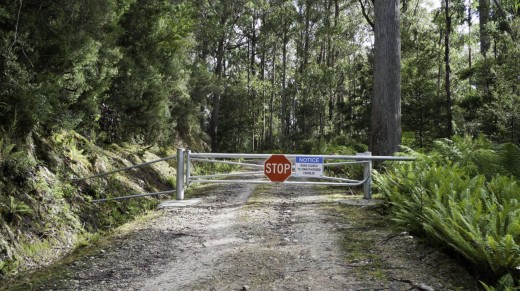 Forestry Tasmania’s locked gate on the public road to the top of Mount Tim Shea
(Suspiciously this public access road was deemed unfit for public travel coincidentally around the same time as Forestry Tasmania opened its ‘Adventure Hub’ in Maydena,
and equally coincidentally one of the hills they charge people for a ride to the top from reads ‘Adventure Hub’).
(Photo by Alan Lesheim) Forestry Tasmania’s locked gate on the public road to the top of Mount Tim Shea
(Suspiciously this public access road was deemed unfit for public travel coincidentally around the same time as Forestry Tasmania opened its ‘Adventure Hub’ in Maydena,
and equally coincidentally one of the hills they charge people for a ride to the top from reads ‘Adventure Hub’).
(Photo by Alan Lesheim)
.
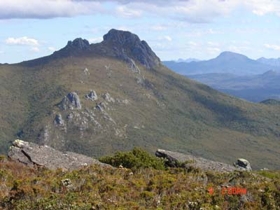 Rugged Mount Tim Shea, South-West Tasmania Rugged Mount Tim Shea, South-West Tasmania
Photo by Forestry Tasmania
^http://www.forestrytas.com.au/topics/2008/06/maydena-adventure-hub-opportunities
.
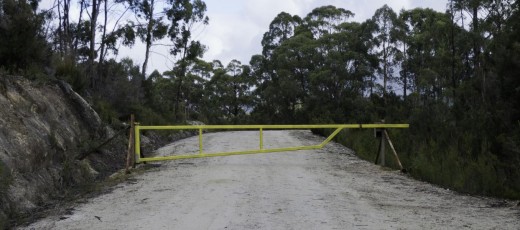 Locked Gate on Five Road in the Upper Florentine Locked Gate on Five Road in the Upper Florentine
(connects to Cook’s Track which enters the Gordon River Road short of Camp Flozza)
(Photo by Alan Lesheim)
.
Forestry Tasmania has hundreds of these padlocked gates throughout Tasmania’s wild forests.
The Wilderness Society’s spokesperson Amanda Sully said “Forestry Tasmania have a locked boom gate over the Huon Valley Wilderness and are refusing entry. This is just one of hundreds of gates on forestry roads in Tasmania.
“It’s very clear who is locking up the forests. People are sick and tired of seeing log truck after log truck coming from the clear felling behind these padlocked gates.
These are publicly-owned forests.
Forestry Tasmania is supposed to manage them for the benefit of all Tasmanians, not just the loggers” Ms Sully concluded.
.
[Source: ‘Forestry Tasmania – Locking up our forests‘, ^http://www.wilderness.org.au/campaigns/forests/19980924_mr
.
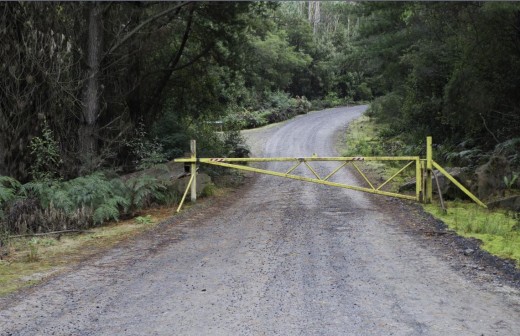 Forestry Locked Gate on Blue Road, northern section of the Upper Florentine Valley Forestry Locked Gate on Blue Road, northern section of the Upper Florentine Valley
(Photo by Alan Lesheim)
.
.
Author Anna Krien was on a quest for the truth described in her revealing expose book of 2010 into what’s stihl happening in Tasmania’s wild forests:
~
‘Most people travelling through Tasmania will never know of the long-running hide-and-seek taking place in the labyrinth of logging roads beyond the bitumen.
Sightseers walk among 300-year-old trees, some of them 90 metres tall, in the Styx Big Tree Reserve, chainsaws can be heard in the distance.
The road into this attraction is lined with stage sets of wilderness.
At the rise of a hill, just before the nose of the car tilts downwards, passengers might glimpse a balding peak, a fleeting insight into the world behind the verge.’
~
[Source: ‘Into the Woods: The Battle for Tasmania’s Forests‘, 2010 by Anna Krien pp.25-26, published by Black Inc. ^http://www.blackincbooks.com/books/woods, includes video interviews].
.
So, this Editor, half way through the book, last month flew down to Hobart, hired a car and retraced the author’s journey into Tasmania’s South-West …
.
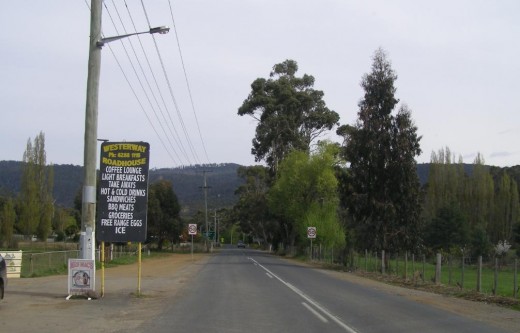 Driving west along the old Hydro Electrical Commission’s (HEC) Gordon River (Access) Road,
through Forestry’s logging town of ‘Westerway’ Driving west along the old Hydro Electrical Commission’s (HEC) Gordon River (Access) Road,
through Forestry’s logging town of ‘Westerway’
.
Noticeably, when driving out of Hobart I passed clearly wealthy residential suburbs, yet driving along the Gordon River Road these few isolated hamlets are not wealthy. Their construction mostly seems temporary like mining companies would construct while the mine delivers. The highway through the hamlets of Westerway, Fitzgerald and Maydena seems only for forest access, not for community.
I parked the car and walked through Maydena.
There is only the odd person out and about. The place seems impoverished – one small primary school, a notable lack of shops, lack of amenities, and little sign of any vibrant community.
It’s as if the profits from logging have driven right through the guts of these local villages and on to big corporations eastward.
.
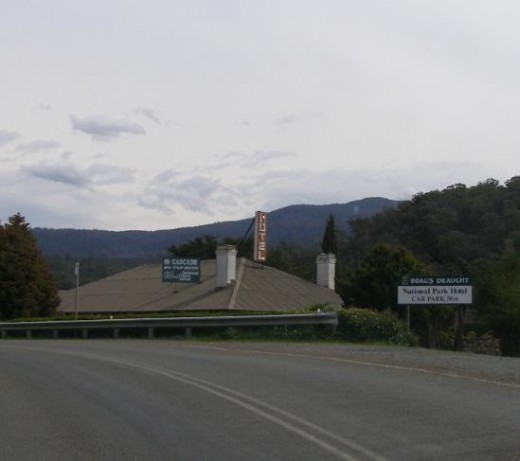 Past the National Park Hotel
where Tasmania’s champion wood-chopper ‘Big Dave’ holds pride of place above the pub’s fire place. Past the National Park Hotel
where Tasmania’s champion wood-chopper ‘Big Dave’ holds pride of place above the pub’s fire place.
.
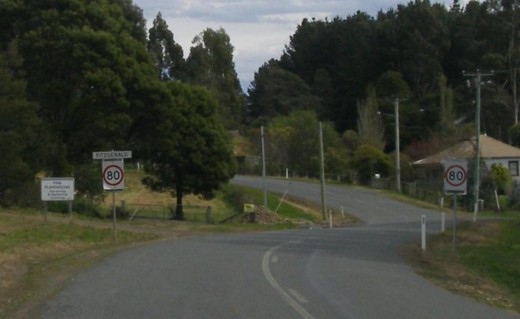 Driving through Forestry’s old logging town of ‘Fitzgerald’
. Driving through Forestry’s old logging town of ‘Fitzgerald’
.
.
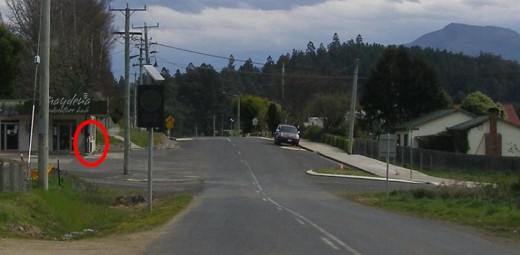 Driving through the old logging town of ‘Maydena’
– a closed so-called ‘Adventure Hub’ on the left, yet its diesel bowser (circled) open for Forestry Tasmania vehicles and observed in used by Editor 20110928. Driving through the old logging town of ‘Maydena’
– a closed so-called ‘Adventure Hub’ on the left, yet its diesel bowser (circled) open for Forestry Tasmania vehicles and observed in used by Editor 20110928.
.
Reminiscent of Australia’s 1850s Gold Rush, Tasmanian folk would have been lured west by Forestry to the promise of bountiful tall timber delivering reliable logging income and the promise of building personal wealth.
But along the Gordon River Road there is a stark absence of Forestry wealth. Instead it seems Forestry has abandoned these Gordon River Road communities.
What Forestry has done is to sell out Tasmania’s traditional woodcraft industry for short term profit from flogging quality Tasmanian hardwood as cheap asian woodchips, destroying Tasmania’s forests timber communities in the process. Then Gunns got greedy and Tasmania’s timber reputation has deteriorated thereafter.
Now Forestry Tasmania are clearfelling and selling out Tasmania’s rare forests to the asians direct, to the likes of Ta Ann. Forestry Tasmania is no more than a corporate pimp of Tasmanian rare forest heritage.
.
“The road into this attraction is lined with stage sets of wilderness.”
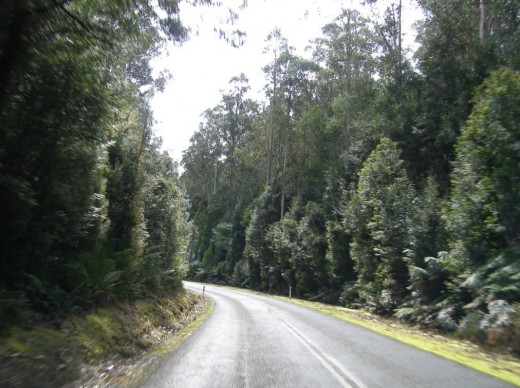 Driving further west along the HEC Gordon River Road
– bulldozed in 1964 through 64km of pristine wilderness forest by the Hydro Electric Commission, and
funded by the then Menzies federal government at a cost of £2.5 million (likely twenty times that in today’s terms – i.e. $50 million.
. Driving further west along the HEC Gordon River Road
– bulldozed in 1964 through 64km of pristine wilderness forest by the Hydro Electric Commission, and
funded by the then Menzies federal government at a cost of £2.5 million (likely twenty times that in today’s terms – i.e. $50 million.
.
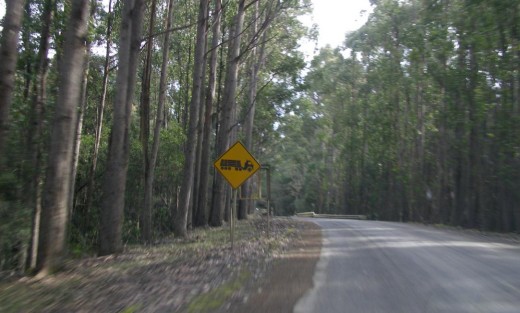 Gordon River Road – signposted logging country Gordon River Road – signposted logging country
.
“At the rise of a hill, just before the nose of the car tilts downwards, passengers might glimpse a balding peak”
 The balding peak of Forestry Tasmania’s cable logging…’a fleeting insight into the world behind the verge’.
(Photo by editor 20110928 while on Gordon River Road heading west) The balding peak of Forestry Tasmania’s cable logging…’a fleeting insight into the world behind the verge’.
(Photo by editor 20110928 while on Gordon River Road heading west)
.
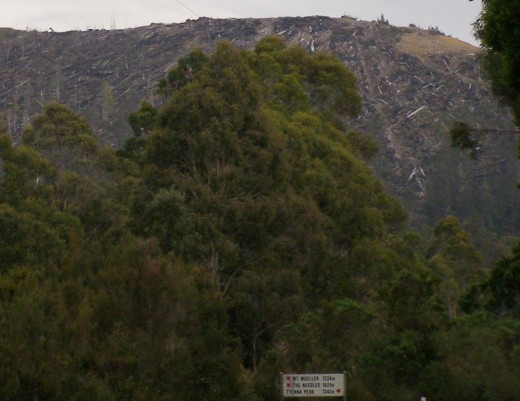 An entire hill of wild Tasmanian forest savagely cabled logged bare by Forestry Tasmania
Tourists can now see this from Gordon River Road.
(Photo by editor 20110928. Click photo to enlarge.)
An entire hill of wild Tasmanian forest savagely cabled logged bare by Forestry Tasmania
Tourists can now see this from Gordon River Road.
(Photo by editor 20110928. Click photo to enlarge.)
.
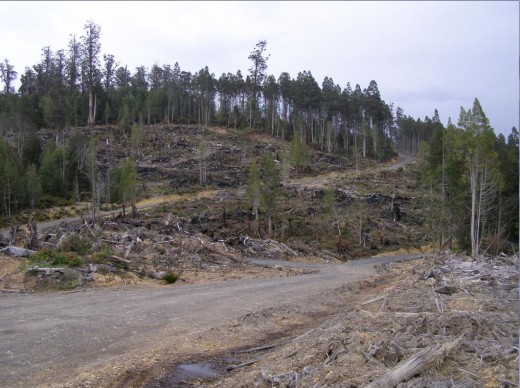 Beyond the lock gates lies the ecological holocaust
(Photo by editor 20110928. Click photo to enlarge.) Beyond the lock gates lies the ecological holocaust
(Photo by editor 20110928. Click photo to enlarge.)
.
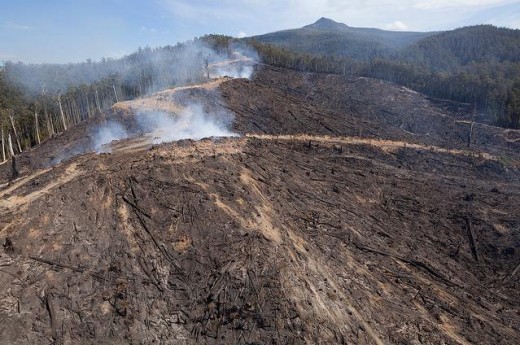 Styx Valley Holocaust
(Photo by Rob Blakers) Styx Valley Holocaust
(Photo by Rob Blakers)
.
 Tasmania’ s Styx Holocaust
September 2011 (Photo by Alan Lesheim)
Tasmania’ s Styx Holocaust
September 2011 (Photo by Alan Lesheim)
.
 Forestry Tasmania’s Killing Fields
Forestry Tasmania’s Killing Fields
.
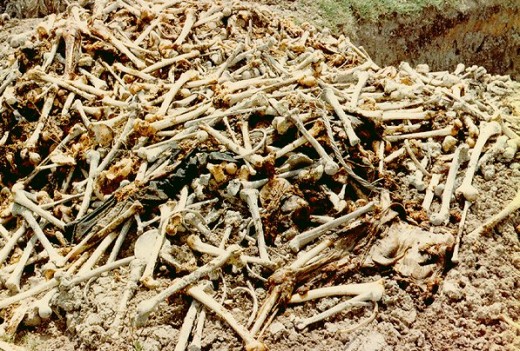 Cambodia’s Khmer Rouge Killing Fields
(Human mass murder comparable to Tasmania’s mass forest murder
– both crimes consistently against life) Cambodia’s Khmer Rouge Killing Fields
(Human mass murder comparable to Tasmania’s mass forest murder
– both crimes consistently against life)
.
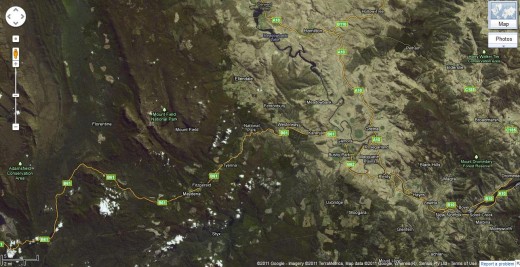 Google Maps (September 2011) satellite view of the forest rape by Forestry Tasmania
.
Google Maps (September 2011) satellite view of the forest rape by Forestry Tasmania
.
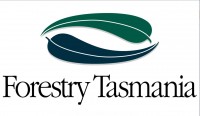 . .
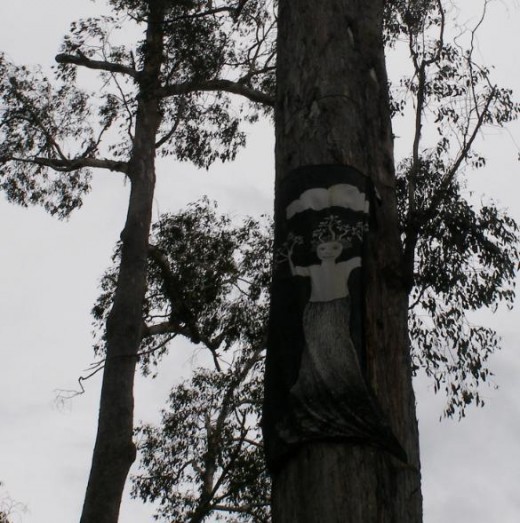 Camp Flozza’s symbolic goddess of the ancient Florentine Forest
~ eco-raped by Forestry Tasmania in its January 2009 raid
Camp Flozza’s symbolic goddess of the ancient Florentine Forest
~ eco-raped by Forestry Tasmania in its January 2009 raid
.
 And they wonder why the people protest and are prepared to be arrested?
(Photo of forest defender being arrested at Forestry Tasmania’s police raid on Camp Flozza,
Upper Florentine Valley, 13th January 2009) And they wonder why the people protest and are prepared to be arrested?
(Photo of forest defender being arrested at Forestry Tasmania’s police raid on Camp Flozza,
Upper Florentine Valley, 13th January 2009)
.
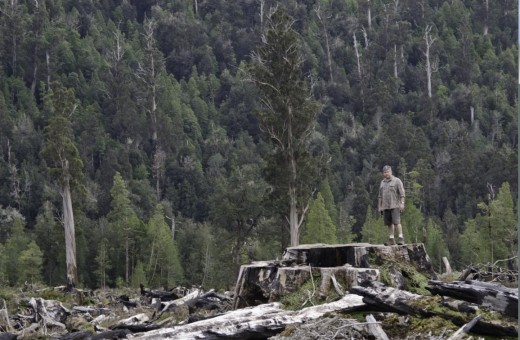 Styx Valley Holocaust by Forestry Tasmania, September 2011
(Photo of editor 20110928. Click photo to enlarge.)
Styx Valley Holocaust by Forestry Tasmania, September 2011
(Photo of editor 20110928. Click photo to enlarge.)
.
.
Forestry Tasmania padlocks gates 10 kilometres from clearfell around a protected Wedge-tailed Eagle nest
[Source: ‘Loggers breach eagle nest protection laws again‘, Bob Brown, 20090827, ^http://bob-brown.greensmps.org.au/category/issues/environment/forestry/wielangta]
‘In the breeding season, a clear felling operation in Tasmania’s wild Upper Huon Valley has breached guidelines by smashing down forests next to an endangered Tasmania’s Wedge-tailed eagles’ nest. The Tasmanian Wedge-tailed eagle, with wingspan up to 3 metres, are one of the Earth’s 6 largest eagle species.
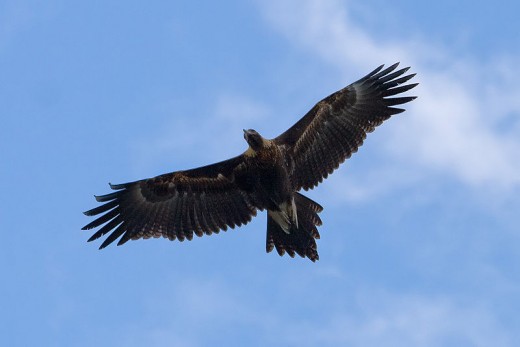
“After repeated controversies about woodchip operations burning or destroying eagle nests and causing failure of nesting because of bulldozers and chainsaws operations near nests, this failure of protection in the Huon is inexcusable. It makes a mockery of logging industry propaganda,” said Australian Greens Leader Bob Brown.
“The Ministers for Forestry and Environment who are responsible for Australia’s rare and endangered species don’t know, and don’t act in any helpful way.”
“It is as if the Howard Government never left office. These ministers have washed their hands of their role in the Wedge-tailed eagles’ fate. Logging laws in Tasmania state that a minimum of 10 hectares be left around an eagle’s nest,” said Senator Brown.
Forestry Tasmania has erected locked gates 10 kilometres from the nest logging site preventing public or media inspection.’
.
Footage of the logged area and nest available here (on YouTube):

.
.
Meanwhile Forestry Tasmania on its ‘Adventure Forests‘ website promotes its ‘Top of the World Tour‘ from Maydena…

…’Go wild where eagles soar…Make the escape to the Eagle’s Eyrie on a Top of the World Tour.You’ll experience all the fun of the Railtrack Rider as you travel into the heart of the forest to explore long-abandoned bush heritage, before emerging to an alpine wonderland and an eagle’s eye view over the Tasmanian wilderness. There’s plenty of time for indulgence as well, with an individually-prepared gourmet lunchbox and fine regional wines enjoyed in the fireside comfort of the Eagles Eyrie.’
^http://adventureforests.com.au/maydena
.
.
‘The real voyage of discovery consists not in seeking new landscapes
but having new eyes’
~ Marcel Proust, French novelist
Tags: Anna Krien, Cable Logging, Camp Flozza, deforestation, Fitzgerald, Florentine Valley Holocaust, Forestry Holocaust, Forestry Locked Gates, Forestry Tasmania, Gordon River Road, having new eyes, Into the Woods, Maydena, Maydena Adventure Hub, Mount Tim Shea, National Park hotel, Styx Big Tree Reserve, Styx Forest, Styx Valley, Styx Valley Holocaust, Ta Ann, Tasmania, Tasmania's Ancient Forests, Tasmania's South West, Tasmania's Wild Forests, Upper Florentine Forest, Wedge-tailed Eagle, Westerway, wild forests
Posted in Eagles, Tasmania (AU), Threats from Deforestation, Threats to Wild Tasmania | No Comments »
Add this post to Del.icio.us - Digg
Thursday, September 15th, 2011
The following article was published on CanDoBetter.net today (20110915) by wildlife ecologist and biologist, Hans Brunner, under the title: ‘A planned slaughter of endangered wildlife’
.
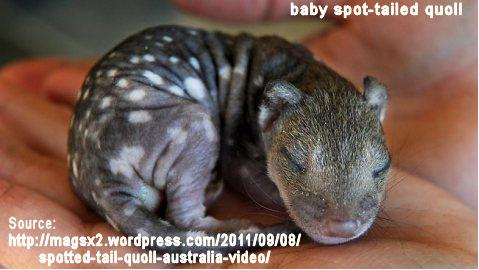
The Victorian Government plans to drop 1080 poison bait from an aircraft into forests could result in the extinction of the already critically endangered Spotted-tailed Quoll.
The purpose of this antiquated and vandalistic method is to poison wild dogs. Why is the Victorian Government using old, dangerous methods? This is like re-introducing the use of DDT. It is now a double disaster; all Ted Baillieu has to do now is to aerial bait to kill wild dogs in order to protect the cattle he allowed to go back into the mountains! Spot-tailed quolls and other dasyurids are meat eaters as well as some species of possums, reptiles, bandicoots and birds. They would be all at a serious risk of being poisoned. Further more, most of this bait would be wasted because of the dogs not being able to find them and this is where non-target animals will rather find and eat them. Baits have therefore to be placed only in places which dogs frequently use, along forest tracks.
.
More effective methods
There is a well researched and efficient method for the poisoning of wild dogs and foxes. It is a target specific bait station system which is successfully used throughout Victoria. Bait stations are placed along forest tracks where activities of dogs are observed.
A bait station consists of a mound of soil about 20 cm high and one meter in diameter. An un poisoned bait (free feed) is buried in the center of the mound about 10cm deep with some SFE lure placed on top. When the bait has been dug up and eaten, a check is made, with some experience, to assess whether a dog or fox took the bait. If satisfied that a target species took the bait it can be replaced with a poison bait. If it appears that a quoll or an other non-target animal may have taken the free feed bait, continue free feeding that station to keep the quoll and others away from a poison station (about 2 km away) or eliminate that station.
.
This is the only responsible way to poison dogs and foxes. Even better, it will be of great benefit to not only the quolls by removing the competition by dogs and foxes of their natural prey species, but also for the survival of Kangaroos, wallabies, bandicoots, possums, echidnas etc.
.
Biologist’s experience of alternatives
I have researched and tested this system in 700 square km of forest between Gembrook and Neerim and found it most effective and efficient. I have also introduced it in NSW National Parks where it was recognized as “The dog baiting stations proposed by Hans are the best practical suggestion to date. With the implementation of the bait stations, properly maintained and serviced at the appropriate times, there would appear to be NO reason to allow the continued use of aerial baiting” and, “Poisoning using the buried bait technique is still proving extremely target specific, with dogs and foxes being the only species killed”.
.
Do it the right way and wildlife return
Barbara Triggs, an eminent naturalist stated after poisoning wild dogs and foxes and using the bait station system on her property in Croajingolong National Park, East Gippsland:
.
“At no time has there been any evidence that a bait has been taken by a non-target animal. In the past year the numbers of native animals seen on the property have increased startlingly. The Red-necked Wallabies, who’s group was here in low numbers, have increased markedly from five individuals to now at least fourteen. The most surprising increase has been in the population of Long-nosed Bandicoots. The Dusky Antechinus, Swamp Rats, Water Rats, Sugar Gliders and several species of ground-nesting birds and also species of owls are much more in evidence than ever before.”
.
With all this evidence, this non specific and irresponsible aerial baiting must be immediately stopped.’
Hans Brunner
Wildlife biologist
Sept 2011
|
|
 ‘The Tarkine’ – 430,000 hectares of ancient Tasmanian forest
‘The Tarkine’ – 430,000 hectares of ancient Tasmanian forest Cradle Coast Authority (CCA), North West Tasmania’s map
as part of a tourism development strategy.
Cradle Coast Authority (CCA), North West Tasmania’s map
as part of a tourism development strategy.
 Moss-clad Sassafras (Atherosperma moschatum) trees in the Arthur River catchment near Waratah, Tarkine, Tasmania
(Photo © Ted Mead November 2003)
[Front Cover of the 2004 book, ‘Tarkine‘ edited by Ralph Ashton, and available from publishers Allen and Unwin,and just purchased by The Habitat Advocate.
Available at: ^http://www.allenandunwin.com/default.aspx?page=94&book=9781742372846]
Moss-clad Sassafras (Atherosperma moschatum) trees in the Arthur River catchment near Waratah, Tarkine, Tasmania
(Photo © Ted Mead November 2003)
[Front Cover of the 2004 book, ‘Tarkine‘ edited by Ralph Ashton, and available from publishers Allen and Unwin,and just purchased by The Habitat Advocate.
Available at: ^http://www.allenandunwin.com/default.aspx?page=94&book=9781742372846]
 This is how the ‘Tin Men‘ see the Tarkine… for its tin and tungsten.
(Source: Venture Minerals’ Mt Lindsay-Investor Presentation, Nov 2011)
This is how the ‘Tin Men‘ see the Tarkine… for its tin and tungsten.
(Source: Venture Minerals’ Mt Lindsay-Investor Presentation, Nov 2011)
 …and this is how the ‘Tin Men’ see the Tarkine… for the vast mining lease area they are happy to exploit and lay to waste.
…and this is how the ‘Tin Men’ see the Tarkine… for the vast mining lease area they are happy to exploit and lay to waste. …and this is how the Tin Men see the Tarkine – for its ‘Super Mining Profits’ … 30 to 55% return!
…and this is how the Tin Men see the Tarkine – for its ‘Super Mining Profits’ … 30 to 55% return! Corporate Miner ‘Metals X’ getting well stuck into a Tarkine rainforest hillside at nearby Mount Bischoff
Corporate Miner ‘Metals X’ getting well stuck into a Tarkine rainforest hillside at nearby Mount Bischoff
 The Tarkine is a refuge for healthy Tasmanian Devils to avoid the genocidal tumour disease
..but what could heartless commercial ‘Tin Men’ care?
Think of the ‘Super Mining Profits’ … 30 to 55% return!
The Tarkine is a refuge for healthy Tasmanian Devils to avoid the genocidal tumour disease
..but what could heartless commercial ‘Tin Men’ care?
Think of the ‘Super Mining Profits’ … 30 to 55% return!
 Nearby Mount Bischoff Tin Mine – wam, bam, thank you mam!
Nearby Mount Bischoff Tin Mine – wam, bam, thank you mam!

 The Tasmanian Minerals Council claims that there are “already enough layers of protection across the Tarkine region, where about 80% of the land has been put in multiple use reserves that allow mining“.
The Tasmanian Minerals Council claims that there are “already enough layers of protection across the Tarkine region, where about 80% of the land has been put in multiple use reserves that allow mining“. ‘Here at Melaleuca, six days’ walk from the nearest road,
such moments of peace are typically broken by bird calls,
including the distinct buzzing of the orange-bellied parrot’.
.
[Source: ‘Scientists Race To Rebuild Parrot Population’, by Peter Ker, Sydney Morning Herald, 20110207, ^http://www.globalanimal.org/2011/02/07/scientists-race-to-rebuild-parrot-population/29032/]
‘Here at Melaleuca, six days’ walk from the nearest road,
such moments of peace are typically broken by bird calls,
including the distinct buzzing of the orange-bellied parrot’.
.
[Source: ‘Scientists Race To Rebuild Parrot Population’, by Peter Ker, Sydney Morning Herald, 20110207, ^http://www.globalanimal.org/2011/02/07/scientists-race-to-rebuild-parrot-population/29032/]





























































